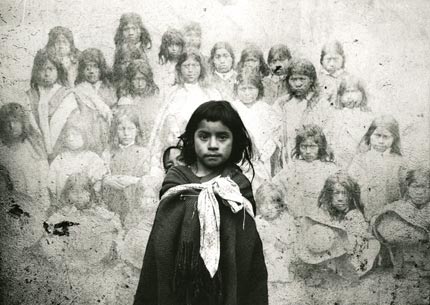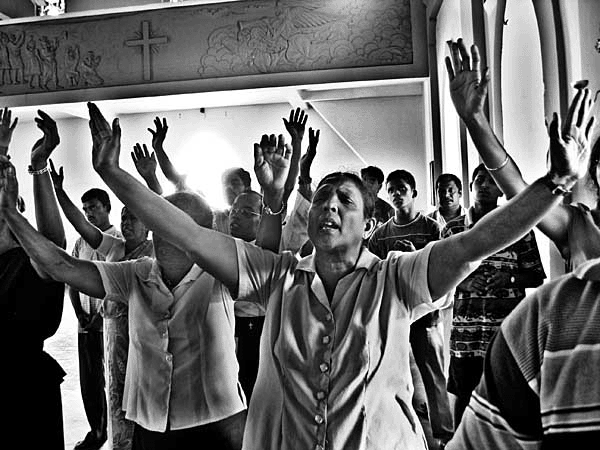By Rupert Grey
On the way over here I read the obituary of Francoise Demulder.? Some of you will remember that she was the first woman to win the World Press Photo of the year Award in 1977. The photograph was topical enough ? Palestinians in Beirut. She was one of the stars of the Paris ? based agencies which made France the centre of world photo-journalism during the last years of the golden age of European and US photographic magazines. Like many photographers here in the sub- continent/Bangladesh she felt ?compelled to document how it always was the innocent who suffered while the powerful get richer and richer?. Like a lot of photographers here she was an artist, and she bore witness to the times during which she lived.
I am glad to be back here – this is my third Chobi Mela ? and most particularly to see such a rich diversity and high standard of photography over the last few days and – importantly for me – many powerful documentary images which reflect the same passion for justice which drove Demulder, to be a part of the struggle for change in lives of the oppressed.
1.?? The Title
The title of my talk tonight is Shahidul?s fault. He sent me an email a couple of weeks ago and asked me to give this talk tonight and said could he have the title by return. Just about to go to print, he said.? I thought for a few seconds and recalled a phrase which appeared on the introductory page to one of Banksy?s books which I brought as a present for someone before Christmas: copyright is for losers. Catchy enough, but it raises a question which is central to the profession of photography. Banksy is a well known artist in London. So well known that nobody quite knows who he is: his art takes the form of graffiti in public spaces, and I should imagine that he has a very healthy disrespect for the establishment; so it was surprising, and yet not surprising, to see at the foot of the same page that Banksy invoked the protection of the law of copyright for his book.
2.?? The Central Issue
Banksy?s schizophrenic approach to copyright symbolises the conflict, the tension, between the desire for artists to find their way into the minds of all people, and the need for those artists (and their agents) to maintain a monopoly in order to earn a living. This question, how society produces and distributes its information, literature and art, goes to the very core of freedom. It is an international issue – who gets to say what, to whom? Who has access to it, who gets paid? The answers determine political outcomes. They determine wealth. They determine the extent to which an individual is able to play a central role in altering his or her own life. All this is governed by the law of intellectual property.
3.?? History of Copyright
Hogarth, the great cartoonist whose images of 17th century life in England are central to our understanding of his era, refused to permit his works to be publicly exhibited until Parliament passed an act prohibiting copying. Which is why the first Copyright Act in UK legislation is called Hogarth?s Act. The first in history, I think. The protection was narrow and the duration short. Since then there has been a great deal of legislation in which the overall trend (to put it mildly) has been to increase protection, reduce the exceptions and extend the duration. Before the 1911 Act in Britain ? on which copyright law in Bangladesh is based ? the protection was between 7 and 14 years. In 1911 it was increased to 50 years from creation of the work. In 1956 it was increased further to 50 years from 1st publication. Towards the end of the last century it was 70 plus life of the author. Policy makers and their advisors regarded the ownership of intellectual property as they did motor cars: you owned it exclusively, and when you lent it to somebody else – or granted a licence if it is was copyright – it was on strict terms. The thinking was that the more it was protected the more artist & writers would produce their works.
The US patent system was overhauled in the early 1980?s ? protection was strengthened ? the reach and scope of exclusivity was broadened; and the same thing happened to copyright and trade marks. Universities registered patents and required the payment of royalties: thus institutions dedicated to disseminating knowledge, information and understanding in the widest possible way were in fact impeding the sharing of that knowledge as if they were a commercial enterprise. The proprietary model for disseminating information was, and is, in the ascendant.
4.?? Internet
At the same time, reflecting perhaps the same concerns, a counter-trend has developed. As the law tightens the control given to the rights-owners and cultural producers, the consumer pushes in the opposite direction: in the networked information economy the ethic of sharing exchanging, building on the past, is the primary driver.? Social networks share ? with abandon and some would say a blithe disregard for their own privacy -? information, knowledge and culture ? so that the political and legal pressures which favour the proprietary business model runs head-on into a generation of savvy and determined consumers. There is an increasing resistance to attempts to enclose the information environment. International boundaries, indeed boundaries of all kinds, are becoming blurred, cultural values fused, sovereignty pooled authority subverted. Creative commons, the non profit organisation dedicated to granting royalty-free licenses, expands the range of creative work available to others to build on and share.? There is, in short a strong movement which aims to counter the restrictions of the permission culture erected by the dominant producers of culture and the legal systems they (largely) control.
5.?? ?One up on the Greeks?
I have selected, somewhat randomly, three cases to illustrate these conflicting trends: Perfect 10, the soft porn empire in the US, sued Google for enabling users to access Perfect 10?s thumbnail images of Perfect 10?s nude models. Google?s defence, that it was an exception to the usual rule (fair dealing, in lawyers? jargon), failed in the lower court and won in the higher court. A significant victory for the consumer.
Last year a New Zealander called Elliot Smith uploaded a hundred videos from YouTube. No problem there, though I dare say there was an infringement or 2, but then he made the mistake of uploading Olympics footage without permission. Within 12 hours his entire account was completely deleted. The owners of the Olympic footage were savvy enough, or rich enough, to have at their disposal the necessary technology to force YouTube (now Google of course) to cut off anyone who is accused of infringing copyright. Whether or not they turn out to be guilty is no longer of interest. This is pretty outrageous. The judgment has been widely criticised as ?deeply flawed?. Victory by technology, aka bullying, rather than law.
Google also feature in the third case I want to mention. It is by far the biggest and most significant. It settled just before Christmas. Four years ago Google started scanning millions of books onto the web. It asked permission of neither the publishers nor the authors, and pretty soon it got sued by both. Google?s aim was along the same lines as the chief librarian in the great library of Alexandria, burned to the ground by Caesar three centuries before Christ in one of the most destructive acts of vandalism in world history: Google wants to set up a library containing every single book, article, play or art work written or created in the history of the world. The Great Library in Alexandria housed, it is thought, between 40 and 70% of everything that had been written by that stage in world history. Google, not to be outdone by the Greeks is aiming for 100%. Furthermore, it maintains, access to its library is simple and free, neither of which was the case in Alexandria?s case.
As their archivist some what arrogantly remarked ?this is our chance to get one-up on the Greeks? It will be an achievement remembered throughout time ? in short, the entire works of human kind, from the beginning of recorded history, in all languages, available to all people, all the time?. Worth mentioning in this context, I suppose, is that all this information, that is to say all the information that is can currently be housed in a building about the size of a small town library. No doubt tomorrow it will all fit into your Ipod.
Battle over copyright infringement commenced in the States but the ramifications are worldwide. Eventually Google caved in, and paid out 125 million to the Association of American Publishers and the Authors Guild. Part of the damages ? US$34.5 million ? will be spent by Google in creating a ?book rights registry?, to make sure that authors are compensated for the use of their works. It will be independent of Google, and will oversee payments to authors much as the equivalent of the music industry oversee payments to songwriters and musicians. Google also agreed to pay $60 for every book uploaded onto the web, and to charge a licence fee of which 68% will go to the authors. For reasons that are wholly unclear, photographs were not included in this agreement, and thus no doubt will be excluded from access on the web.
6.?? Searches
The new technology of searching renders archaic the concept of copyright; when is the process of copying an infringement, as opposed to just making it available?? Enabling a connection? Is it the same as creating a copy, in the ordinary sense?? There is a value in the connection created by the search, and the value of the work is increased the more it is shared. To put it another way, as no doubt Google did, the value of the created work is increased enormously by allowing a billion new connections. That in the previous generation would have been completely inconceivable. It is publishing on a scale which is incomprehensible.? Is that good for the creator? Is it, in effect, free advertising which will enhance a reputation, or a massively outrageous infringement of copyright for which compensation should be justly awarded?
7.?? Review of Copyright Law
Against this background, it is not surprising that the law of copyright is being reviewed by Western Governments and the UK in particular. David Lammy, the Minister for Higher Education and Intellectual Property, launched the review earlier this year, pointing out that 8.3% of the UK GDP ? at least as it was (down a bit since then I expect) ? and is growing at twice the rate of the economy as a whole. It follows the Gower review a couple of years ago, amongst whose recommendations were to reform the copyright provisions in relation to orphan works ? that is to say works to which owners cannot be identified after reasonable enquiries have been made by the prospective publisher ? and secondly, a recommendation that a further copyright exception should be created for user generated content, on the basis that it is ?transformative?? – technical jargon for which I have so far read or heard about 6 definitions.
Implicit in these proposals is an acknowledgment that the high level of copyright protection considered to be crucial for intellectual creation and development should to an extent be tempered. The European Commission?s recent green paper on copyright and the knowledge economy points out that the balance between ensuring a reward for creation and investment and the future dissemination of knowledge has been challenged, or rendered less effective, by the evolving internet technology. Difficult to argue with that.
A great deal of debate has been generated by these prospective changes, particularly the proposed orphan works exception; and the transformative use exception has been described as artistic stealing. These are significant steps within the framework of our existing copyright law.
8.?? The Answer?
I have no idea. But I have three thoughts for photographers:
It is now critically important to ensure that your name is tagged to every one of your images on the web. Your paternity right is now more valuable than your copyright. It is the key to the management of your reputation as a photographer, and it is that reputation which will generate your income; by the same token, and equally important, tagging your name will prevent it becoming an orphan work.
Secondly technology. Not my field, to say the least of it, but programmes (on subscription) are now available to trace your image wherever it appears or is accessed on the web. They use advanced identification and algorithms to identify your images by the composition of its pixels, so its appearance on the internet sends an instant notification to the owner of the copyright.? In theory you can then ask for a fee, but the real point is that it works the other way round: publishers can use it to identify copyright holders, and will need to if they are to take advantage of the orphan works legislation.
Thirdly new business models are arriving on the scene. On-line agencies aren?t just stock agencies; some of them commission work and actively engage with publishers. As the number of bricks & mortar agencies (and publishers) dwindle, undercut by fast-moving & shrewd on-line players with minimal overheads, the market-place is changing. In change there is opportunity.? And more the point, it does not matter whether you are here in Dalhmundi Bangladesh or in London?s Covent Garden. The only thing that matters is the quality of your image and the content ? and accuracy ? of your text.
According to the British Journal of Photography in London there are now 3 trillion images on the web. That was last August. So there?s a bit of competition.? But judging by the quality of some of the work I have seen in the last couple of days I can see no reason, particularly if you subscribe to a tracking device, why you should not be able to make a living out of photography.
Rupert Grey of Swan Turton, Solicitors
3 February 2009
Transcript of lecture by Rupert Grey @ the Goethe Institute in Dhaka on? 4 February 2009. Dhaka, Bangladesh
* Acknowledgments to Banksy
(It is the third time that Rupert Grey has attended Chobi Mela)
Category: Photojournalism issues
What Matters
Subscribe to ShahidulNews
The World’s Preeminent Photojournalists and Thinkers Depict Essential Issues of Our Time
Sterling. 2008. 335p. ed. by David Elliot Cohen. photogs. index. ISBN 978-1-4027-5834-8. $27.95. POL SCI
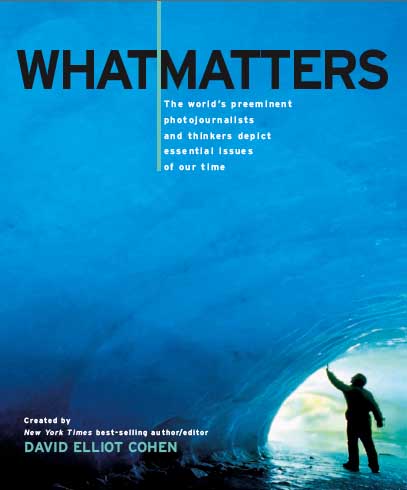
PHOTOGRAPHY EXPOSES TRUTHS, advances the public discourse, and demands action. In What Matters, eighteen important stories by today?s preeminent photojournalists and thinkers poignantly address the big issues of our time?global warming, environmental degradation, AIDS, malaria, the global jihad, genocide in
Darfur, the inequitable distribution of global wealth and others. A “What You Can Do” section offers 193 ways to learn more and get involved.
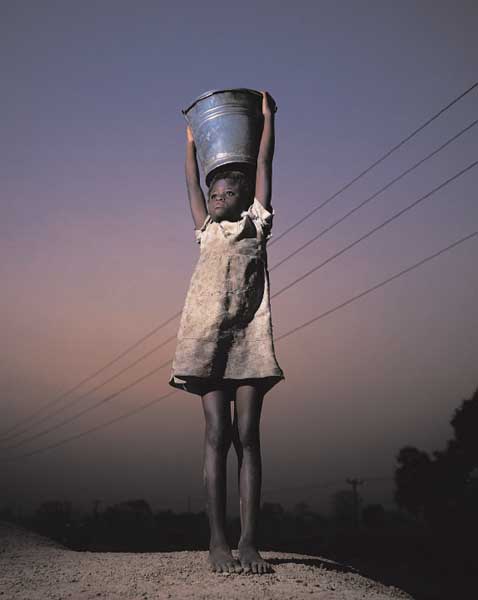
Photographed by:
Shahidul Alam ? The Associated Press ? Gary Braasch ? Marcus Bleasdale ? Raymond Depardon ? Paul Fusco ? Lauren Greenfield ? Maggie Hallahan ? Ed Kashi ? Gerd Ludwig ? Magnum ? Susan Meiselas ? James Nachtwey ? Shehzad Noorani ? Gilles Peress ? Sebasti?o Salgado ? Stephanie Sinclair ? Brent Stirton ? Tom Stoddart ? Anthony Suau ? Stephen Voss
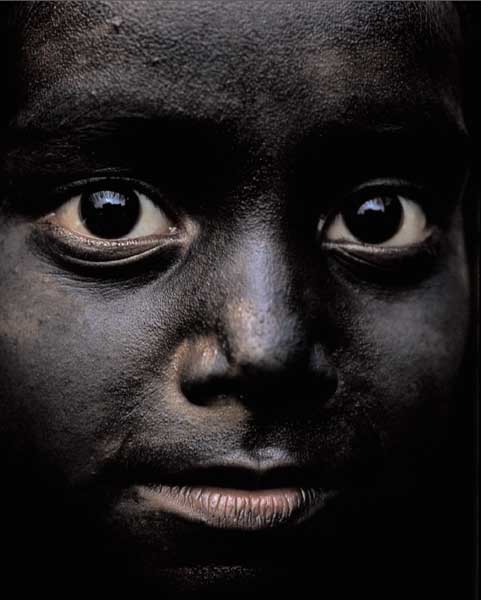
Commentary by:
Omer Bartov ? Judith Bruce ? Awa Marie Coll-Seck ? Richard Covington ? Elizabeth C. Economy ? Helen Epstein ? Fawaz A. Gerges ? Peter H. Gleick ? Gary Kamiya ? Paul Knox ? David R. Marples ? Douglas S. Massey ? Bill McKibben ? Samantha Power ? John Prendergast ? Jeffrey D. Sachs ? Juliet B. Schor ?
Michael Watts
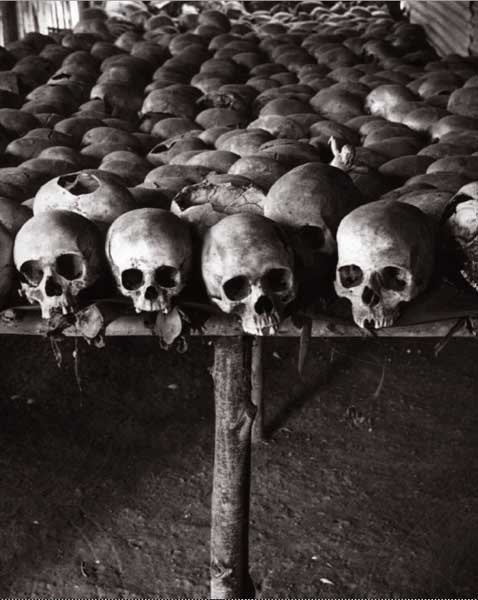
What Matters?an audacious undertaking by best-selling editor and author David Elliot Cohen?challenges us to consider how socially conscious photography can spark public discourse, spur reform, and shift the way we think. For 150 years, photographs have not only documented human events, but also changed their course?from Jacob Riis?s expos? of brutal New York tenements to Lewis Hine?s child labor investigations to snapshots of torture at Abu Ghraib prison. In this vein, What Matters presents eighteen powerful stories by this generation?s foremost photojournalists. These stories cover essential issues confronting us and our planet: from climate change and environmental degradation to global jihad, AIDS, and genocide in Darfur to the consequences of the Iraq war, oil addiction, and the inequitable distribution of global wealth. The pictures in What Matters are personal and specific, but still convey universal concepts. These images are rendered even more compelling by trenchant commentary. Cohen asked the foremost writers, thinkers, and experts in their fields to elucidate issues raised by the photographs.
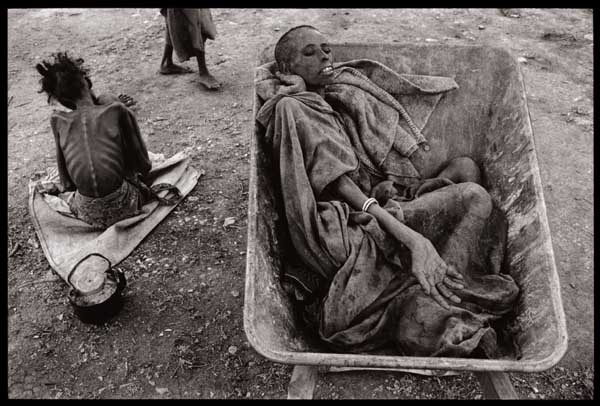
Some stories in What Matters will make you cry; others will make you angry; and that is the intent. What Matters is meant to inspire action. And to facilitate that action, the book includes an extensive ?What You Can Do? section??a menu of resources, web links, and effective actions you can take now.
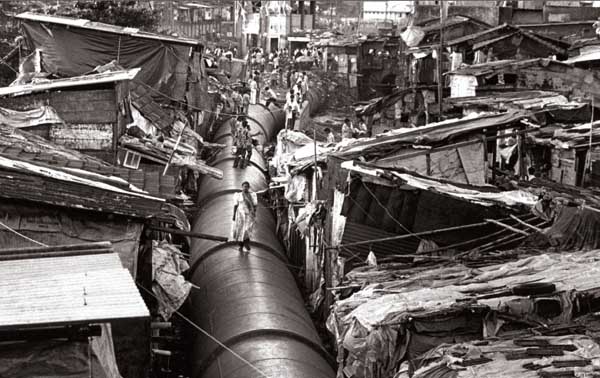
Cohen hopes What Matters will move people to take positive steps??no matter how small??that will help change the world. As he says in his introduction, the contributors? work is so compelling that ?if we show it to you, you will react with outrage and create an uproar.? If, says Cohen, you look at these stories and think, ?What?s the use? The world is irredeemably screwed up,? we should remember that, historically, outraged citizens have gotten results. ?We did actually abolish slavery and child labor in the US; we abolished apartheid in South Africa; we defeated the Nazis; we pulled out of Vietnam. As the saying goes, ?All great social change seems impossible until it is inevitable.? ?
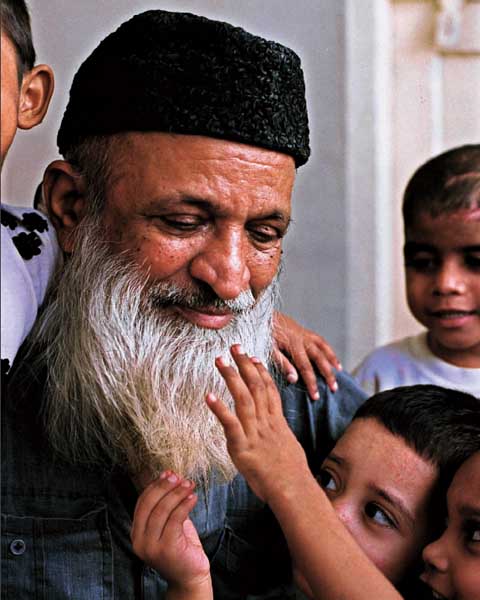
– Michael Zajakowski, Chicago Tribune
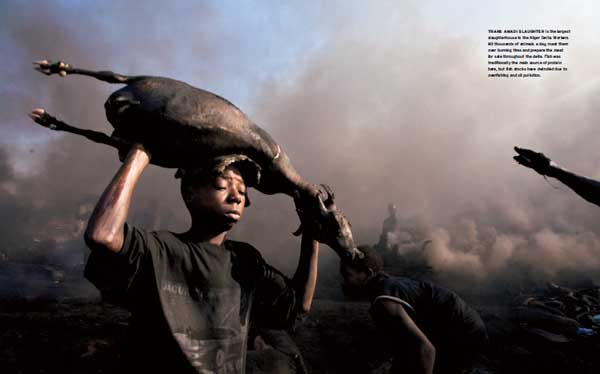
A. Newspapers and Online
1. Hard to see, impossible to turn away – Issues and images combine in ‘What Matters,’ a powerful and passionate new book
“Great documentary photojournalism, squeezed out of mainstream newspapers and magazines in an age of shrinking column inches, has had a hard time gaining traction in other venues… But nobody has told the 18 photographers in “What Matters: The World’s Preeminent Photojournalists and Thinkers Depict Essential Issues of Our Time.” These are photo essays by some of today’s best photojournalists following the great tradition begun over a hundred years ago with the expos?s of New York tenement life by Jacob Riis. Through the doggedness of these photographers?who are clearly committed to stirring us out of complacency?all the power and passion of the medium is evident in this book… Some of the pieces will break your heart, some will anger you. All will make you think. To channel your thoughts and feelings into action, the book ends with an appendix “What You Can Do,” offering hundreds of ways to be a part of the solution to these problems.”
– Chicago Tribune Book Review, 2 page spread
2. “Must viewing.”
– San Francisco Chronicle, 2 page story
3. Photographs that Can Change the World
“David Elliot Cohen?s new book, What Matters, which hits bookshelves today, is a collection of photo essays that explore 18 distinct social issues that define our time. Shot by the world?s most renowned photojournalists, including James Nachtwey, who has contributed to V.F., the photographs explore topics ranging from genocide and global warming to oil addiction and consumerism, offering a raw view into the problems that plague our world. Each photo essay is accompanied by written commentary from an expert on the issue. Cohen hopes the book will inspire people to work toward resolving these problems. ?Great photojournalism changed the world in the past, and it can do it again,? Cohen says. ?I want people to see these images, get angry, and act on that anger. Compelling images by the world?s best photojournalists is the most persuasive language I have to achieve this.?
– vanityfair.com
4. Book Review: What Matters
“Changing the world might sound like a lofty goal for a photo book, but that?s what the new book, What Matters, The World?s Preeminent Photojournalists and Thinkers Depict Essential Issues of our Time edited by David Elliot Cohen (Sterling Publishing, $28, 2008), hopes to do. Citing the power of socially conscious photographers over the last 150 years, the beautiful collection of 18 photo-essays by some of today?s prominent photojournalists hopes to ?inform pre-election debate and inspire direct action.” Regardless of what side of the political fence you sit on, this collection of heartbreaking and powerful stories and images is guaranteed to get you thinking.”
– Popular Photography
5. What Matters: The World’s Preeminent Photojournalists and Thinkers Depict Essential Issues of Our Time.
Those doubting the power of photojournalism to sway opinion and encourage action would do well to spend some time with this book. In 18 stories, each made up of photos by leading photojournalists and elucidated by short essays by public intellectuals and journalists, this book explores environmental devastation, war, disease, and the ravages of both poverty and great wealth. The photos are specific and personal in their subject matter and demonstrate how great photography can illuminate the universal by depicting the specific. Cohen has a goal beyond simply showcasing terrific photography. In his thoughtful introduction, he makes explicit his aim to connect the work compiled here with the great tradition of muckraking photography that helped to change conditions in New York tenements and to end child labor at the turn of the last century. A terrific concluding chapter directs readers to specific actions they can take if they are moved to do so by the book’s images, and it’s hard to imagine the reader who would not be moved. Highly recommended for public libraries and academic libraries supporting journalism and/or photography curricula. (a starred review in Library Journal generally means the book will be acquired by many libraries.)
– Library Journal
6. First of five part series about What Matters
(The first installment drew 500,000 page views)
– CNN.com
7. Second part in CNN. Black Dust by Shehzad Noorani
Bangladesh, standing on the edge
Subscribe to ShahidulNews
Preface?by Christian Caujolle
Expressions, hands, faces, presence and pain, tenderness and anxiety, light and encounters, questions and determination as well as a thousand other things run through Munem Wasif‘s photographs.
The way Wasif takes his photographs can be summed up into two ways: people and the frame. He definitely belongs to a humanist tradition, contemporary in content for the attention he gives to people and to the way they live, what they have to endure and all they bear in today’s pitiless world, disrupted, torn by drastic climatic changes and economic speculation. A world where speed is queen and profit king inconsiderately leaving on the wayside the rejected that it spawns. It is salutary that an eye such as Wasif’s reminds us that these things exist, that there are men, women, children, “little people” like us who have to withstand much more than we do.






In photography, the approach and the representation of suffering and exclusion are often entangled in a jumble of good intentions, generous in intention, they call for tearful compassion, with clich?d images that end up making us weary, forever repeating themselves, they end up by?anaesthetising?our capacity to react. Wasif produces the opposite effect. He makes us question and makes us concerned.

This is done with so little and at the same time goes to the essential. We can not doubt his commitment to those he photographs, the excluded, the victims, panic-stricken by a world ruled by the race for profit and blinded by immediate return based on solely commercial value. He puts this world into form, radical in its description, he imposes it and gives it to us to see clearly.

This is where the frame comes in. A way of focusing in on the world, to sum it up in a series of specific points of view, classic in their composition, forcing us to see and to perceive their intention.
Munem Wasif‘s frames are clean-cut, precise, almost cold. Without flourish. He asks us to look, to perceive, to take a stand. Therefore to act.
—————————
Wasif’s work will be shown at Visa Pour la Image at Perpignan. He won the?City of Perpignan Young Reporter?s Award for 2008. He graduated from Pathshala, The South Asian Institute of Photography, and works at DrikNews. His work is represented by Agence VU and Majority World.
Another View
Subscribe to ShahidulNews
Lucia Chiriboga portrays the deep spirituality in Ecuadorian life. Long before Photoshop became commonplace, Lucia began creating complex images by subtle multiple exposures, as a way of weaving multilayered stories of her ancestors. ? Lucia Chiriboga/Drik/Majority World
It was a grand opening. The ?Who?s Who? of development in Britain was there, championing the noble cause ? the Millennium Development Goals, making poverty history.
The Bob Geldof circus could perhaps be pardoned. Geldof is neither a development worker nor someone particularly knowledgeable about the subject. But for the organizers of the ?bash? at the OXO Tower on London?s South Bank to produce such a culturally insensitive event was revealing.
Apart from parading a few young black people from Africa, who extolled the virtues of ?development?, there was little contribution from the Majority World. The key speakers, typically white Western development workers, spoke of the role that they were playing in saving the poor of the Global South. The token dark-skinned people, having played their part, were soon forgotten.
The centrepiece of this celebration was an exhibition entitled Eight Ways to Change the World. All the photographs were taken by white Western photographers. No-one questioned the implication of such an exercise. When I confronted one of the organizers he explained that the curator ? a director of a Western photographic agency ? had decided not to use Majority World photographers because they ?didn?t have the eye?. The sophisticated visual language possessed by the Western audience was presumably beyond the capacity of a photographer from the South to comprehend, let alone engage with at a creative level.
New rules
This represents a shift from the position of 20 years ago when we started asking why Majority World photographers were not being used by mainstream media and development agencies. The answer then had been: ?They don?t exist.? Today our existence is difficult to deny. The internet; the fact that several Majority World agencies operate successfully; and that photographers belonging to such agencies regularly win international awards: all these things mean we are no longer invisible.
Now it?s a different set of rules. We have to prove we have the eye. A similar statement about blacks, women, or minority groups of any sort, would raise a storm. But when such prejudice is used against a group of media professionals from the South, who happen to represent the majority of humankind, no-one appears to bat an eyelid.
I have, of course, faced this situation before. There was, for example, a fax from the National Geographic Society Television Division asking if we could help them with the production of a film that would include the Bangladeshi cyclone of 1991. They wanted specific help in locating ?US, European or UN people… who would lead us to a suitable Bangladeshi family?. The irony of making such a request to a picture agency dedicated to promoting local voices had obviously escaped them. We had gotten used to requests for iconic objects of poverty that international NGOs insisted existed in abundance and had to be photographed ? but which locals neither knew nor had heard of.
The economics of suffering
Charities and development agencies need to raise money from the Western public. The best way to pull the heart strings ? and thereby the purse strings ? is to show those doleful eyes of the disadvantaged.
Perhaps photographers from the South cannot be trusted to understand this. Perhaps they are so hardened to such images of daily suffering that they are unable to appreciate the impact these sights might have on Western audiences ? and the coffers of Western aid agencies.
But certain changes have been taking place, forcing various adjustments. Media budgets have become tighter than they were. Flying people to distant locations is expensive. Having Western photographers ?on the ground? can be dangerous in some cases ? and costly in terms of insurance premiums. Better to have locals in the firing line. So, slowly, local names have begun to creep in. Certain rules still apply of course, such as the vast differentials in pay between local and Western photographers.
Stories about Nike regularly make the headlines, but the exploitative terms on which local photographers work rarely surface. The Bangla saying ?kaker mangsho kak khai na? (a crow doesn?t eat crow?s meat) seems to apply to journalism: criticism of the media is taboo. Not only do the workers on the media sweatshops have to work for peanuts, they need to know which stories to tell. None of this journalistic independence rubbish: gimme stories that sell.
This, of course, affects Southern photographers. When they know certain stories sell, they themselves begin to supply the ?appropriate? images. A man known to carry a toy gun in the streets of Dhaka is repeatedly photographed at religious rallies, and despite common knowledge that it is a fake gun, news agencies run the picture without explaining the nature of the situation. Numerous wire photographers have been known to stage flood pictures and in one famous instance, a child was shown to be swimming to safety in what was known to be knee deep water. The photograph went on to win a major press award.
Money also affects publishers. Smaller budgets require careful shopping. The Corbis, Getty and Reuters image supermarkets are rapidly squeezing out the ?corner store? suppliers and a small Majority World picture library simply can?t compete.
But there are other factors in the equation. Development isn?t simply about money. What about developing mutual respect; enabling equitable partnerships; providing enabling environments for intellectual exchange? What about creating awareness of the underlying causes of poverty? These are all integral parts of the development process. When all things are added up, cheap images providing clich?d messages do more harm than good. They do not address the crucial issue: poverty is almost always a product of exploitation, at local, regional and international levels. If poverty is simply addressed in terms of what people lack in monetary terms, then the more important issues of exploitation are sidelined.

Materially poor nations should have a say in how they are represented. This picture, taken in the early days of the Maoist movement, by Nepalese photographer Binod Dhungel, shows members of his country?s Maoist Movement long before it was breaking news. ? Binod Dhungel/Drik/Majority World
A broader picture
However, the type of imagery required from the Majority World is broadening. This is coming less from growing political sensibility and more from global economic shifts. Negative imagery is seen as a deterrent to foreign investment in emerging markets. With transnationals interested in cheap labour, and a wider consumer base, a different profile is now required to stimulate investor confidence. So, along with the standard fare of flood and famine, there are stories of Indian and Chinese billionaires and how they have benefited from capitalism.
Furthermore the new ?inclusive? media now take on more ethnic-minority journalists. But when they come over to do their groundbreaking stories, it is the rookie on the streets of Dhaka who provides the leads, conducts the research, translates, drives, fixes, and does all that is necessary for the story to emerge. If things do go wrong ? as when Britain?s Channel 4 TV attempted an ill-fated expos? in Bangladesh in late 2002 ? the Western journalists are likely to be home for Christmas while the local fixers face torture in jail.
Drik?s vision
Lacking the advantages of our Western counterparts, image-makers in the South have had to rely on ingenuity and making-do in order to move from being fixers to being authors in their own right. We have had to be pioneers. With one filing cabinet, an XT computer without a hard drive, and a converted toilet as a darkroom, we decided we would take on the established rich-world photo agencies. On 4 September 1989 Drik Alokchitra Granthagar was set up in Dhaka.
The Sanskrit word Drik means vision, inner vision, and philosophy of vision. That vision of a more egalitarian world, where materially poor nations have a say in how they are represented, remains our driving force.
The European agencies I had encountered wanted a minimum submission of 300 transparencies and told you not to ask for money for the first three years. This constituted a massive investment for a Majority World photographer, and virtually ruled out her entry into the market. We had a very different approach. If a photographer had a single good image which we felt needed to be seen we would take her on, try and sell the picture and pay her as soon as the money came in.
It allowed the photographer to buy more rolls of film and carry on working. The photographers didn?t have printing and developing facilities so we set up a good quality darkroom and trained people to make high quality prints. They had no lights so we set up a studio.
The only gallery spaces available were owned by the State or foreign cultural missions, none of which would show controversial work. So we built our own galleries. Few would publish pictures well so we built our own pre-press unit and published postcards, bookmarks and calendars which we sold door-to-door to pay for running costs.
Photography was largely male-dominated, so we organized workshops for women photographers. There were no working-class people in the media, so we started training poor children in photography. We couldn?t afford faxes or international phone calls, so we set up Bangladesh?s first email service and lobbied for the introduction of fully fledged internet. Professor Yunus, the Nobel Prize winner, was our first user. We set up electronic bulletin boards on issues important to us, such as child rights and environmental issues.
We started putting together a database of photographers in the South, and wrote off to as many organizations as we could, offering our services. No-one replied. Undeterred, we put together a portfolio of black-and-white prints, largely by Bangladeshi photographers.
On a rare visit to Europe, I visited the office of the New Internationalist in Oxford. Dexter Tiranti greeted me warmly. He had received our letter, but hadn?t given it too much importance. An agency in Bangladesh seemed too far distant for the NI to work with on a regular basis. Having seen the portfolio, however, Dexter sat me down at his desk and started ringing picture users across Europe. I remember feeling envious of this ability simply to pick up a phone and call someone in another country, but was grateful for the contacts. Dexter asked us to submit pictures for the NI Almanac. The next year we got a letter from him that stated: ?The photographs are beautiful and the reason we are using only six is because we can?t really have too many from one country.? Others Dexter had phoned that day, and many others we have contacted since, have responded similarly, and so picture sales slowly grew ? but it was no easy ride.
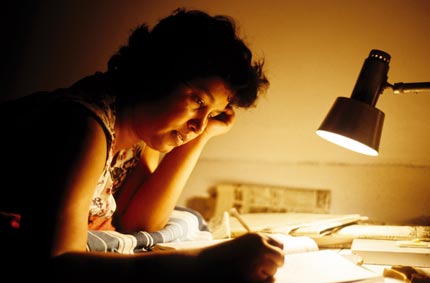
Drik?s email network was put to use when writer and feminist Taslima Nasrin, pictured here in hiding, was being persecuted. ? Shahidul Alam/Drik/Majority World
Knife wounds and death threats
Our problems weren?t simply ones of surviving on slender means and competing against agencies based in London, Paris and New York. Our activism created problems on our home soil too. We had, by then, set up our own website and had helped to establish the first webzine and internet portal in the country. Our email network had been put to use when Taslima Nasrin was being persecuted. The website became the seat of resistance when pro-government thugs committed rape in a university campus. So the site, and later the agency, came under attack.
The day after our human rights portal www.banglarights.net was launched, all the telephone lines of the agency were disconnected. It took us twoand- a-half years to get the lines back, but that never stopped our internet service and we stayed connected. Later, Drik became the seat of resistance when the Government used the military to round up opposition activists. I was attacked on the street, during curfew and in a street protected by the military. I received eight knife wounds.
So we learnt to walk a fine line.
It wasn?t just the Government that found us unpalatable. The US embassy felt it couldn?t work with us because we opposed President Clinton?s visit to Bangladesh.

Letter by John Kinkannon (director of USIA in Bangladesh) to Mayeen Ahmed, coordinator of Chobi Mela (2000).
The British Council demanded we take down a show that talked about colonialism, and threatened that future projects might be jeopardized when we openly opposed the invasion of Iraq. Death threats, some real, some less serious and a whole range of sabotage attempts have been part of the path we?ve travelled.
Current strategies are more subtle. We know we will never be given work by certain agencies and that visas for some of us will be more difficult to get, but it is certainly not all negative. The main strength of Drik has been its friends and their support. None of what we have achieved would have been possible without the contribution of a large number of people, ranging from ordinary Bangladeshis who have rallied when it mattered, to influential people thousands of miles away who have provided moral and material support. Combining our compulsion to be socially effective with the requirement to be financially independent has remained our biggest challenge. It is a difficult balancing act.
A great high
Taking a principled position has other drawbacks. People work long hours for salaries below the industry norm. There are few perks. But working at Drik is a special experience; a great high. Not everyone can survive on these highs, of course, and job satisfaction doesn?t help pay the bills, so we need to be competitive and ensure a level of quality so that we can hold our own despite the political pressures.
Eighteen years down the road, we now have a workforce of around 60. Graduates from our school of photography, Pathshala, hold senior positions in major publications. The working-class children we?ve trained have gone on to win Emmys and other awards, and I believe Majority World photographers feel they have a platform.
The big agencies like Reuters and Getty can provide images at a cost and a speed impossible for independent practitioners to match, a very real consideration for picture editors under time pressure and working to tight budgets. The fact that Corbis (owned by Microsoft) is buying up picture archives like the Bettman is important for their preservation, but the images that now exist 200 feet below the rolling hills of western Pennsylvania are no longer accessible to the students, scholars and researchers. An important part of our visual history is now in the control of one person ? Bill Gates.

Golam Kasem (nicknamed Daddy) was Drik?s oldest photographer when he died at the age of 103. His original glass plates date back to 1918. This 1927 image is one of many where Daddy records everyday life in rich detail. ? Golam Kasem/Drik/Majority World
Fair trade
Father Paul Casperg, who has been working for many years with the tea plantation workers in Kandy, has an interesting story to tell. Nearly 30 years ago, in his Masters thesis at the London School of Economics, Father Casperg was able to show that an increase of two pence (four US cents) in the price of a cup of tea being sold on the British railways would, providing it went to the Kandy tea plantation workers, result in more income than the total foreign aid received by the Sri Lankan Government.
Father Casperg rightly concluded that it was fair trade that Sri Lanka needed, not more aid.
That is what fair trade imagery organizations like majorityworld.com and kijijiVision (see Action) are trying to do. By invoking ethical standards in the trading of images, these organizations address not only the distorted and disrespectful depiction of people of the Global South, but also the economic divide.
Organizations that call for Majority World governments to be more transparent and accountable need to reflect upon their own ethical standards when it comes to depicting and dealing with the South. Practices such as not allowing photographers to retain copyright or film are justified by the ?convenience? of distributing images. Such ?convenience clauses? are rarely applied to Western photographers, who know the law and can exercise their rights.
Light, flexible, potent
We are resisting, though. The new portal, majorityworld.com, supported strongly by its lobbying partner kijijiVision.org, has built on the extended groundwork done by Drik. DrikNews.com, though still very young, threatens to give the wire agencies a run for their money, and photographers in the South are pooling their resources, including developing close partnerships with like-minded Western organizations.
Recently, I was sitting with a small group of photographers, painters and filmmakers in a corner of the top-floor gallery of the Voluntary Artists Society of Thimpu (capital of Bhutan). At the end of the showing of a film on Chobi Mela IV ? the festival of photography in Asia ? projected on a bedsheet pinned on the gallery wall, the conversation veered to pooling resources in neighbouring countries. Sharing computers, scanners, and contacts, we talked of bus routes to neighbouring countries, and finding public spaces for showing work. What we needed was an online solution that would serve all Majority World photographers.
Having purchased expensive software produced in the West for selling pictures online, we were further bled by consultancy fees we had to pay every time we needed to adapt it to our situation. So, eventually, we developed our own software. It is an inexpensive but highly efficient search engine that local newspaper archives can use. Developed using largely open-source modules, it is constantly updated based on feedback from users from all over the globe and it has worked well on low bandwidth.
Groups in Bhutan, Peru, Tanzania and Vietnam recognize that the wire services and the big agencies have a different agenda. If it?s a guerrilla war against the corporations that has to be fought, then we need different tools. Light, flexible, inexpensive and potent ones.
A revolution is taking place. As new names creep into the byline, unfamiliar faces step up to the award podium and fresh imagery ? vibrant, questioning and revealing ? makes it into mainstream media, a whole new world is opening up. A Majority World.
Originally published in the New Internationalist Magazine in August 2007
Image take-over
In the 1990s independent picture libraries and agencies disappeared at an alarming rate as they were absorbed or driven out of business by larger ones. Dominating the field was Corbis, created by Microsoft Corp founder Bill Gates. Corbis now has 24 offices in 16 countries, represents some 29,000 photographers and controls around 100 million images. Last year it acquired the Australian Picture Library, entered a partnership with IndiaPicture.com and opened a new office in Beijing. Its 2006 revenue was more than $251 million.
Other big players have included Getty Images, founded in 1995, which now has 20 offices worldwide and controls over one million images. Jupiterimages, a division of the Connecticut-based Jupitermedia Corporation, manages over seven million images online, while Reuters has an archive of over two million images.
In recent years the microstock photography industry, led by iStockPhoto and later ShutterStock, Dreamstime, Fotolia, and BigStockPhoto has emerged as a rapidly growing market. Using the internet as their sole distribution method, and recruiting mainly amateur and hobbyist photographers from around the globe, these companies are able to offer stock libraries of pictures at very low prices. Corporate giants Corbis, Getty and Jupiterimages have now muscled their way into this market too, adding to their everexpanding fortfolio of the world?s imagery.
Ghosts
Subscribe to ShahidulNews
By Ian Buruma
Volume 55, Number 11 ? June 26, 2008
The New York Review of Books
Two photographs, taken by digital camera at Abu Ghraib prison, on the night of November 5, 2003. The first picture shows a person in a ragged black poncho-like garment standing precariously on a tiny box. Hairy legs and arms suggest that this person is a man. His head is covered in a pointed black hood, his arms are spread, and his fingertips are attached to wires sticking from the concrete wall behind him. The pose hints at a crucifixion, but the black poncho and hood also suggest a witch or a scarecrow.
The second picture shows a young woman hunched over the corpse of a man. The corpse lies in a half-unzipped black body bag filled with ice cubes wrapped in plastic. His mouth is open; white bandages cover his eyes. The young woman grins widely at the camera. She holds up the thumb of her right hand, encased in a turquoise latex glove.
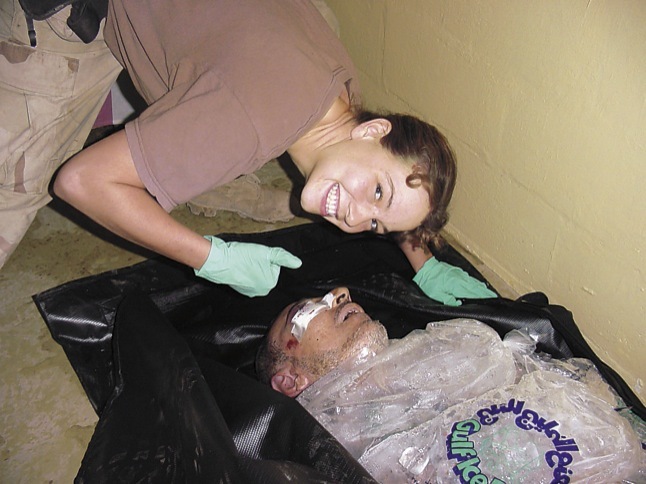
The photographs look amateurish, a crude mixture of the sinister and lighthearted. When they were published, first in The New Yorker magazine, we were provided with some background to them, but not much. The anonymous man in the first picture had been told that he would die of electric shock if he fell off the box. Hence the wires, which were in fact harmless. Information about the second picture was sketchy, but the woman seemed to be gloating over the man’s death. The bandages suggested serious violence. There were other Abu Ghraib photographs, published widely on the Internet: of terrified Iraqi prisoners, stripped of all their clothes, being assaulted and bitten by dogs (“doggie dancing”); of a naked prisoner on all fours held on a leash by a female American guard; of naked men piled up in a human pyramid; of naked men made to masturbate, or posed as though performing oral sex; of naked men wearing women’s panties on their heads, handcuffed to the bars of their cells; of naked men used as punching bags; and so on.
The photographs evoked an atmosphere of giddy brutality. The reputation of the United States, already tarnished by a bungled war, hit a new low. But interpretations of the photographs, exactly what they told us, varied according to the observer. After he was criticized for failing to apologize, President Bush said in a public statement that he was “sorry for the humiliation suffered by the Iraqi prisoners, and the humiliation suffered by their families.” But he felt “equally sorry,” he said, “that people who have been seeing those pictures didn’t understand the true nature and heart of America.” Donald Rumsfeld deplored the fact that the pictures had been shown at all, and then talked about charges of “abuse,” which, he believed, “technically is different from torture.” The word “torture” was carefully avoided by both men. President Bush, confronted much later with questions about a damning Red Cross report about the use of torture by the CIA, spelled out his view: “We don’t torture.”[1]
Susan Sontag, writing in The New York Times Magazine, had a different take on the pictures. She thought the “torture photographs” of Abu Ghraib were typical expressions of a brutalized popular American culture, coarsened by violent pornography, sadistic movies and video games, and a narcissistic compulsion to put every detail of our lives, especially our sexual lives, on record, preferably on public record. To her the Abu Ghraib photos were precisely the true nature and heart of America. She wrote:
Soldiers now pose, thumbs up, before the atrocities they commit, and send the pictures to their buddies. Secrets of private life that, formerly, you would have given anything to conceal, you now clamor to be invited on a television show to reveal. What is illustrated by these photographs is as much the culture of shamelessness as the reigning admiration for unapologetic brutality.[2]
Many liberal-minded people would have shared instinctively not only Sontag’s disgust but also her searing indictment of modern American culture. One of the merits of Errol Morris’s new documentary on the Abu Ghraib photographs, and even more of the excellent book written by Philip Gourevitch in cooperation with Morris, is that they complicate matters. What we think we see in the pictures may not be quite right. The pictures don’t show the whole story. They may even conceal more than they reveal. By interviewing most of the people who were involved in the photographic sessions, delving into their lives, their motives, their feelings, and their views, then and now, the authors assemble a picture of Abu Ghraib, the implications of which are actually more disturbing than Sontag’s cultural critique.
At first no one knew the dead man’s name. He was one of the “ghost prisoners,” brought into the “hard site” of Abu Ghraib by anonymous American interrogators, dressed in black, also known to the MPs as “ghosts.” These ghosts belonged to the OGA, Other Government Agency, which usually meant the CIA. Ghost prisoners were not formally registered before their interrogation in shower cubicles or other secluded parts of the prison. They disappeared as swiftly as they came, after the ghost interrogators were done with them. All that the MPs heard of their presence were screams in the night. If the Red Cross visited, the ghost prisoners were to be hidden away.
The man who would soon die arrived in the night before the photographs published in The New Yorker were taken, with a sandbag over his head, and nothing but a T-shirt on. MPs were told to shackle his hands to a window behind his back in “a Palestinian hanging position” (a technique allegedly used but certainly not invented by the Israelis). The man was breathing heavily. Then the MPs were dismissed. An hour or so later, they were called back in to help. The prisoner was no longer responding to questions. They hung him higher and higher, until his arms seemed at breaking point. Still no response. A splash of cold water. His hood was lifted. The MPs noticed that his face had been reduced to a bloody pulp. He had been dead for some time. The ghosts quickly left the scene. Medics were called in to clean up the mess, bandages were put over his puffed-up eyes, and the corpse was zipped into an ice-filled body bag and left in a shower room until it could be removed. The officer in charge of the MPs at Abu Ghraib, Captain Christopher Brinson, declared that the man had died of a heart attack.
Meanwhile, in the same prison block, another torment was taking place. Another nameless prisoner had been brought in, suspected of having killed an agent from the US Army’s Criminal Investigative Division (CID). He refused to divulge his name, so he was handed over to Specialist Charles “Chuck” Graner, an army reservist. Graner, a hulking mustachioed figure, seen laughing at the misery of Iraqi prisoners in many Abu Ghraib pictures, was not trained as an interrogator; nor did he have more than the vaguest idea of the rules and conventions that are supposed to guide interrogations. A corrections officer in civilian life, Graner enjoyed a “bad boy” reputation, with a taste for sinister pranks and an eye for the girls. He should never have been put in charge of terror suspects. He did not even have the security clearance to be a military policeman with custody over prisoners.
Nonetheless, Graner was put in charge of the nameless prisoner and told by CID agent Ricardo Romero to “make his life a living hell for the next three days and find out his name.” Graner did his best, aided by Sergeant Ivan Frederick and other members of their Maryland reserve unit who happened to be around and were equally untrained in interrogation work. The prisoner was stripped of his clothes, yelled at, made to crawl on the floor, deprived of sleep, forced to stand on a tiny box, hooked up to wires sticking from the wall and told he would die if he so much as moved. This last game lasted for about fifteen minutes, long enough for Graner to take his photographs.
Morris didn’t manage to interview Graner. He is still in a military prison. But other witnesses of what happened that night, such as Specialist Sabrina Harman, claim that not much harm was done to the prisoner they nicknamed “Gilligan.” She said that he ended up laughing at the Americans, and actually became a popular guy of sorts, being given the privilege of sweeping up the prison cells. “He was just a funny, funny guy,” she said. “If you were going to take someone home, I definitely would have taken him.”
Sabrina Harman also happens to be the young woman in the second picture, hunched over the corpse. Like Graner, she worked as a guard on the night shift at Abu Ghraib. Harman is described by other interviewees in Morris’s film as a sweet girl who, in the words of Sergeant Hydrue Joyner, “would not hurt a fly. If there’s a fly on the floor and you go to step on it, she will stop you.” The reason she joined the army was to pay for college. Her dream was to be a cop, like her father and brother. Not just a cop, but a forensic photographer. She loved taking pictures, with a special interest in death and decay. Another prison colleague, Sergeant Javal Davis, said: “She would not let you step on an ant. But if it dies, she’d want to know how it died.”
So when water started seeping out of the locked shower cell, and she and Graner uncovered the dead man in his body bag, her first instinct was to take pictures. She told Morris and Gourevitch that she
kind of realized right away that there was no way he died of a heart attack, because of all the cuts and blood coming out of his nose. You don’t think your commander’s going to lie to you about something. It made my trust go down, that’s for sure.
This is when Graner asked her to pose with the body. Harman adopted the pose she always did in photos, with her friends, with prisoners, in the morgue, and now in the shower: she grinned and stuck her thumb up.
Later, she returned to the same place alone, curious to find out more. She took off the gauze over the dead man’s eyes and “just started taking photos of everything I saw that was wrong, every little bruise and cut.” She realized how badly the man had been beaten up:
It looked like somebody had either butt-stocked him or really got him good, or hit him against the wall…. I just wanted to document everything I saw. That was the reason I took photos. It was to prove to pretty much anybody who looked at this guy, Hey, I was just lied to. This guy did not die of a heart attack. Look at all these other existing injuries that they tried to cover up.
In her interview with Morris, Harman looks rather impressive: intelligent, articulate, plausible. The interviews are actually more like monologues, for with rare exceptions Morris’s questions are never heard. His genius is to get people to talk, and talk, and talk, whether it is Robert McNamara in The Fog of War or Sabrina Harman in Standard Operating Procedure. The fact that he paid some of his interviewees for their time has been held against Morris by some critics. It seems of little importance. There is no reason to believe that cash changed their stories. If only the film had stuck to the interviews. Alas, they are spliced together with gimmicky visual reenactments of the scenes described in words, which take away from the stark air of authenticity. But perhaps that is Morris’s point. Authenticity is always elusive. Nothing can be totally trusted, not words, and certainly not images, so you might as well reimagine them.
But I think we are meant to believe that Harman is telling the truth. Her letters from Abu Ghraib to her lesbian partner, Kelly, suggest as much. On October 20, 2003, she wrote about a prisoner nicknamed “the taxicab driver,” naked, handcuffed backward to the bars of his cell, with his underwear over his face:
He looked like Jesus Christ. At first I had to laugh so I went on and grabbed the camera and took a picture. One of the guys took my asp and started “poking” at his dick. Again I thought, okay that’s funny then it hit me, that’s a form of molestation. You can’t do that. I took more pictures now to “record” what is going on.
Two pictures, then. The first one, of Gilligan and the electric wires, was analyzed by Brent Pack, a special forensic expert for the CID. After much thought, he concluded:
I see that as somebody that’s being put into a stress position. I’m looking at it and thinking, they don’t look like they’re real electrical wires. Standard operating procedure?that’s all it is.
He was technically right. A memo drawn up by the Pentagon’s general counsel, William J. Haynes, on November 27, 2002, recommending authorization of interrogation techniques in Category II?which included humiliation, sensory deprivation, and stress positions?was formally approved by the secretary of defense. Donald Rumsfeld even scribbled his famous quip at the bottom of this memo, stating: “However, I stand for 8?10 hours a day. Why is standing limited to 4 hours? D.R.”[3]
And yet this picture, more than any other, including the ones featuring attack dogs and wounded naked bodies, became the most notorious, an icon of American barbarism, the torture picture par excellence, perhaps because, as Gourevitch writes, it left so much to the imagination. That, and its evocation of the crucifixion, Christ at Abu Ghraib. And Sabrina Harman? She was sentenced to six months in prison, a reduction in rank to private, a forfeiture of all pay and allowances, and a bad conduct discharge. None of the men who were responsible for her subject’s death were ever prosecuted. No one above the rank of sergeant was even tried. As Morris said in an interview to promote his film, Harman and her friends caught in the photographs
were punished for embarrassing the military, for embarrassing the administration. One central irony: Sabrina Harman was threatened with prosecution for taking pictures of a man who had been killed by the CIA. She had nothing whatsoever to do with the killing, she merely photographed the corpse. But without her photographs we would know nothing of this crime.
It was just another death of a ghost delivered by ghosts.
2.
Morris has been faulted for not pointing his finger more directly at people more senior than Harman, Graner, Frederick, or Lynndie England, Graner’s girlfriend at the time, who held the naked prisoner on a leash. But this is missing the point of the film. For it is not about Washington politics or administration lawyers, or at least not directly, but about a particular kind of concealment, the way photographs which seem to tell one story actually turn out to hide a much bigger story. Compared to what was really happening at Abu Ghraib, where men were tortured to death in hidden cells, where children were incarcerated with thousands of other prisoners, most of them blameless civilians, exposed to daily mortar attacks, living in unspeakable conditions of filth and squalor, where there was no way out even for men who had been declared innocent, where unarmed prisoners were shot dead by nervous guards?compared to all that, the photograph of Gilligan was just fun and games.
The first thing human beings do when the unspeakable becomes standard operating procedure is to change the words. Even the Nazis, who never seemed to have been unduly bothered by what they did, invented new words, usually of a cold bureaucratic nature, to conceal their crimes: “special treatment” and so on. In public, the US policy toward “security detainees” or “unlawful combatants,” to whom, according to White House and Pentagon lawyers, the Geneva Conventions did not apply, was couched in the kind of language favored by Vice President Dick Cheney: “We need to make certain that we have not tied the hands, if you will, of our intelligence communities in terms of accomplishing their mission.”
The phrase “the gloves are coming off” gained currency. As in an e-mail, quoted by Gourevitch, sent to MI unit commanders in Iraq by Captain William Ponce of the Human Intelligence Effects Coordination Cell: “The gloves are coming off gentlemen regarding these detainees. Col. Boltz”? Colonel Steven Boltz, the deputy MI commander in Iraq?”has made it clear that we want these individuals broken.” The likes of Harman, Graner, England, and Frederick were at the very bottom of the chain of command. They were told to “soften up” the prisoners, to make their lives hell. They should “treat the prisoners like dogs,” in the words of Major General Geoffrey Miller, commander of the prison and interrogation camp at Guant?namo Bay. He said this before the photographs were taken, during a visit to Abu Ghraib, where he felt the prisoners were treated too well. His methods, honed at Guant?namo, were soon adopted. One of Morris’s (or Gourevitch’s) more arresting ideas is that the photographs of the treatment meted out to the prisoners are evidence that the people who were ordered to take their gloves off, if you will, had not entirely lost their moral way. Gourevitch writes:
Even as they sank into a routine of depravity, they showed by their picture taking that they did not accept it as normal. They never fully got with the program. Is it not to their credit that they were profoundly demoralized by their service in the netherworld?
Credit is perhaps not the mot juste. Nazis who took pictures of naked women lined up in front of their own mass graves might not have considered the scene quite normal either, but this does not mean that they were not with the program. Heinrich Himmler was well aware that what he was asking from his SS men was not normal. That is why he told them to steel themselves against any feelings of humanity that would hamper them in their necessary task.
That Harman, for one, was often disgusted with what she saw at Abu Ghraib is indeed clear from her letters to her partner, Kelly. And even Graner, the baddest of the bad apples, was apparently taken aback when he was told by “Big Steve” Stefanowicz, a contract civilian interrogator, just how roughly prisoners were to be “broken.” Graner was reminded of 24, the popular television series, starring Kiefer Sutherland, about the necessity of using any means, including torture, to stop terrorists. Graner claims that he told Big Steve: “We don’t do that stuff, that’s all TV stuff.” Graner was surely unaware that 24 had actually been discussed in all seriousness at brainstorming sessions at Guant?namo led by the staff judge advocate, Lieutenant Colonel Diane Beaver. She recalled the mounting excitement among her male colleagues, including men from the CIA and the DIA, as different interrogation techniques were being bandied about. She told Philippe Sands, author of Torture Team: “You could almost see their dicks getting hard as they got new ideas.”
That was in Guant?namo, where ideas were hatched, noted on legal pads, recorded in memos, debated in air-conditioned offices. Now back to Graner in the filth, noise, and menace of constant violence in Abu Ghraib prison. As the authors point out, there is a kind of pornographic quality to many of the pictures which would indicate that Susan Sontag’s cultural critique was not entirely off beam.
The deliberate use of women, for example, in the humiliation of Arab prisoners is striking. Graner may have asked his girlfriend, Lynndie England, to pose for a picture holding a prisoner on a leash. This might have given him, and possibly her, an erotic frisson. And Sabrina Harman, too, is seen to have been a grinning accomplice in several of Graner’s pranks with naked prisoners. That is why she ended up being convicted. But in fact these games?some clearly staged for the camera as cruel photo-ops?were also part of the program. The women’s panties, the nudity in front of women, the poking of the genitals, the enforced simulation of sexual acts, were all part of the program. Graner was told in writing by his commander, Captain Brinson, that he was “doing a fine job.” He was told: “Continue to perform at this level and it will help us succeed at our overall mission.”
The MPs at Abu Ghraib, as Gourevitch rightly observes, knew little about Middle Eastern culture, but they were given “cultural awareness” training at Fort Lee, before being flown out to Iraq. They were told that sexual humiliation was the most effective way to “soften up” Arab detainees. A person does not have to be corrupted by the popular culture deplored by Susan Sontag to be vulnerable to feelings of pleasure when the sexual humiliation of others is officially sanctioned, even encouraged. Graner’s real sin for the administration was not that he went too far (which, measured by any moral yardstick, of course he did), but that he took pleasure in what should have been a grim job. As Dick Cheney said: “It is a mean, nasty, dangerous, dirty business out there, and we have to operate in that arena.” Hard dicks should have been kept strictly out of sight, under conference tables. But Graner turned the dirty business into his own pornographic fantasies; and what is worse, he recorded them on film, for all the world to see.
Lynndie England played a walk-on part in these fantasies. She loved Graner. She would have done anything he wanted. That was her tragedy. England was sentenced to three years in a military prison for maltreating detainees. “All I did was what I was told to do,” she said, in the oldest defense of men and women landed with the dirty work. “I didn’t make the war. I can’t end the war. I mean, photographs can’t just make or change a war.”
Harman, too, acted out her fantasies, of being a forensic photographer, of recording death. As a result, she made the program public, and forced the president of the greatest power on earth to issue a public apology. As Morris says, in his interview: “Under a different set of circumstances, you could imagine Sabrina winning a Pulitzer Prize for photography.” Instead, she was charged not only with dereliction of duty and maltreatment, but with destroying government property and “altering evidence,” by removing the bandages from the dead man’s eyes. She told Morris: “When he died, they cleaned him all up, and then stuck the bandages on. So it’s not really altering evidence. They had already done that for me.” Since her pictures revealed the truth of this statement, these particular charges were eventually dropped.
Both Morris’s film and the book based on it by Gourevitch are devastating, even without going into detail about the complicity, or indeed responsibility, of top officials in the Bush administration. The photographs embarrassed the United States, to be sure. But for the US government, this embarrassment might have actually helped to keep far greater embarrassments from emerging into public view. Preoccupied by the pornography of Abu Ghraib, we have been distracted from the torturing and the killing that was never recorded on film and from finding out who the actual killers were. Moral condemnation of the bad apples turned out to be a highly useful alibi. By looking like a bunch of gloating thugs, “Chuck” Graner, Ivan Frederick, et al. made the law-yers, bureaucrats, and politicians who made, or rather unmade, the rules?William J. Haynes, Alberto Gonzales, David S. Addington, Jay Bybee, John Yoo, Douglas J. Feith, Donald Rumsfeld, and Dick Cheney?look almost respectable.
And Gilligan, by the way, was probably not the man anyone thought he was after all, but an innocent who happened to be in the wrong place at the wrong time. Just like up to 90 percent of the men and boys locked up in Abu Ghraib.
The War That Time Forgot
The Bangladesh war was one of the 20th century’s bloodiest, yet outside the region, little is known about it. Now, 37 years on, an exhibition records the painful birth of a nation.
Tahmima Anam report




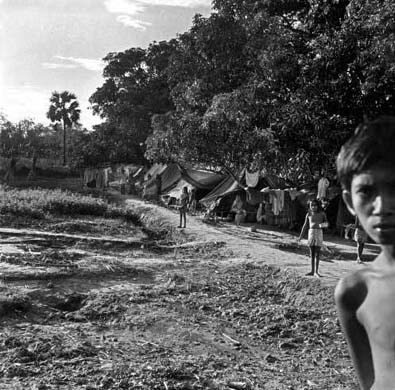
In December 1971, in the midst of their celebrations at the end of the war for independence from Pakistan, the people of Bangladesh began to reckon with the human cost of their new nation. As they took account of what they had won and what they had lost, Sheikh Mujibur Rahman, the independence movement leader who became the first prime minister of Bangladesh, urged his people to embrace the many thousands of women who had been raped by Pakistani soldiers. He gave the women a title – birangona, brave women – seeking both to exalt them as war heroes and erase the shame of their violation.
The contradiction between exalting and forgetting persists in Bangladesh, where the war remains a contested space, still charged 37 years later with an emotional and psychological intensity that brings to life William Faulkner’s words “The past is never dead, it is not even past”.
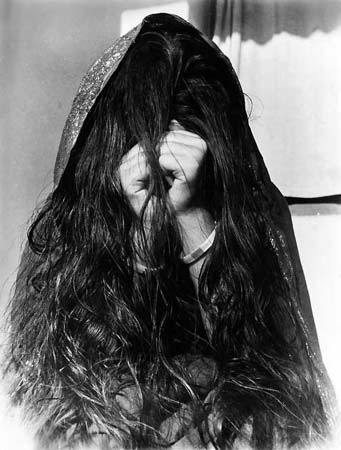
Yet these complexities are captured in a photograph taken by Naib Uddin Ahmed of a woman – one of the birangona – obscuring her face by clutching a thick mass of her own hair. This is just one of many haunting images that make up Bangladesh 1971, a new photographic exhibition at the Rivington Place public gallery in Shoreditch, east London, and which contribute to its powerful visual retelling of the story of this war.
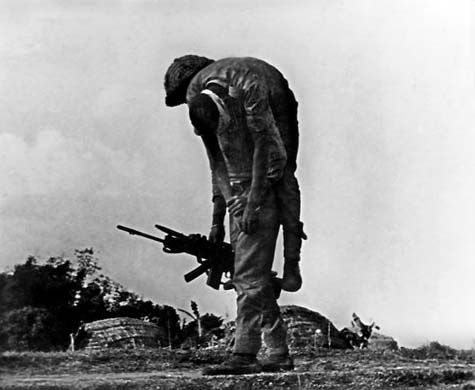
It was one of the bloodiest conflicts of the 20th century, and yet it is a largely unacknowledged event: outside Bangladesh there is little awareness of the campaign of violence on the part of the Pakistani army as the Bengali people of the then East Pakistan sought to achieve political sovereignty.
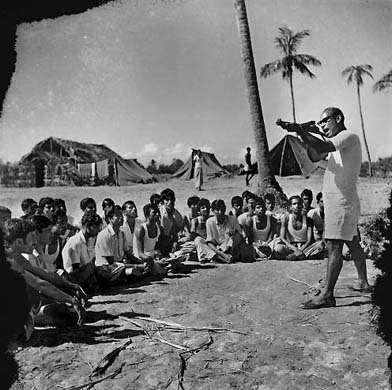
In this exhibition, all but one of the photographers are Bangladeshi; most were amateur photographers at the time, men who happened to be holding a camera when they found themselves caught up in the war. For almost two decades, Shahidul Alam – director of the Drik picture library in Dhaka and a curator of the current exhibition along with Mark Sealy, director of photographic agency Autograph ABP – has made it his mission to collect these photos, visiting the photographers in their homes and saving their negatives. By highlighting the images taken by these accidental archivists, the curators have created an intimate, reflexive portrait of the war, ranging from photographs that are well known to others that have never been seen in public.
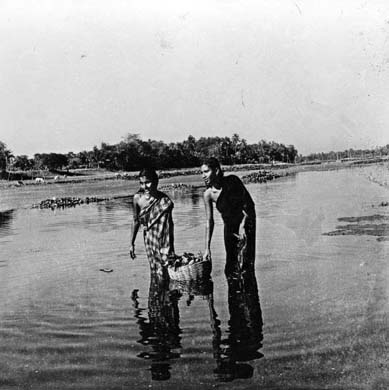


The exhibition consists of more than 100 images organised in loose chronology, beginning with the first stirrings of nationalism and resistance to Pakistani occupation. The ebullient spirit of 1969-70, when war was imminent, is captured most powerfully by Rashid Talukdar’s image of a young boy, no older than 10, leading a street march. The boy is obviously poor (he marches in bare feet) but his mouth is formed in an ecstatic shout as he leads the procession of men behind him, as though for those few minutes, it is his war, his people, his country.
The collection includes many iconic, even universal, images of war: Abdul Hamid Raihan’s image of two children staring into the distance, a carpet of missiles scattered at their feet; Mohammed Shafi’s portrait of a freedom fighter – a boy who could be from anywhere – reveals a young man’s tenderness and fear apparent despite his attempt at studied resolve. Other images reveal the horror of this war with haunting specificity. On the night of December 14, knowing they were about to lose the war, the Pakistani army and its local paramilitary allies massacred the future doctors, teachers, lawyers, and writers of Bangladesh in an effort to cripple the new nation. The bodies were not found until after independence, when a mass grave was discovered in the city. One photograph of the massacre stands out: a face surrounded by submerged bricks and covered in a thin sheen of mud. The face is ghostlike, other-worldly, and the aesthetic intensity of the image serves to underscore the almost unfathomable brutality of the act.
Bangladesh 1971 also presents a complex portrait of the slaughter.
One photograph shows a uniformed man circled by a large crowd, stabbing a civilian with a bayonet; the caption tells us that it is not a Pakistani soldier but a Bengali one, attacking a local man who has collaborated with the army. At Alam’s first exhibition of war photos in Bangladesh, the government requested that he remove this image, in which the roles of victim and perpetrator are reversed. His refusal led to the exhibition being shown at a private gallery rather than at the National Museum.
There are other complex figures, most notably Sheikh Mujib. Revered throughout the independence struggle as the father of the nation, then brutally assassinated in 1975, Mujib left a legacy that is continually being reassessed, not least because his daughter, Sheikh Hasina Wajed, is a prominent Bangladeshi politician. Naib Uddin Ahmed’s photograph of Mujib returning to Dhaka in January 1972 (he had been in prison in Pakistan throughout the war) emphasises the passion he inspired in his followers, as his procession is surrounded by thousands of cheering citizens of the newborn country. But the most touching portrait of Mujib is one where he is shown embracing his daughter, the young Hasina. He glows with pride, and she with love. It’s a reminder that behind every political execution – and south Asia has had its share – is the death of a loved one.
It is in its attempt to challenge our expectations that the exhibition is most successful. In the flagship piece, displayed against the window of Rivington Place, a group of women march in perfect formation through the middle of a busy road, rifles cupped in the palms of their hands. Another photograph is a seemingly idyllic image of two women wading through a pond with a basket of flowers. But the caption reads: “During the liberation war, female freedom fighters would smuggle grenades in baskets covered with water hyacinth.” Scenes like this were common during the independence movement: many young women were given informal military training; in the villages, especially among the Adivasi hill people, women smuggled arms to the front lines of the resistance. Bringing these images to light in this setting challenges our notions of women’s political participation in a country like Bangladesh. And as Londoners walk past Rivington Place, perhaps they will find a new window into the history of their neighbours on Brick Lane, a visual testament to the trauma and hope of independence.
Bangladesh 1971 is at Rivington Place, London EC2A 3BA, until May 31. Info: +44 (0)20-7749 1240.
In pictures: the Bangladesh 1971 Gallery
This article appeared in on on p12 of the section. It was last updated at 02:07 on April 10 2008.
Time Magazine article:
Time Magazine photo gallery:
Historic news clip about killings in Khulna
Death by firing squad in Dhaka University
Indian news clip
Distances
Subscribe to ShahidulNews

Rahnuma Ahmed
WHENEVER I approach her, I feel numb. I feel speechless. I want to know who she is. But I don?t know who to ask. How to ask.
This photograph has always haunted me. I don?t remember when I first saw it. Probably in a book of war photographs. And later in the Muktijuddho Jadughar, where I have gone many a times with relatives and friends, visiting from abroad.
?She was pulled out. Dragged out from the Pakistani army?s bunker,? said Naibuddin Ahmed, the photographer.
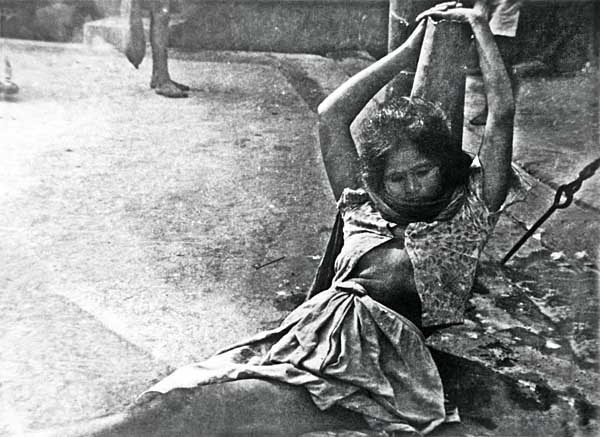 Woman recovered from Pakistani Army bunker at Mymensingh. 12th December 1971. ? Naibuddin Ahmed/Drik/Majority World
Woman recovered from Pakistani Army bunker at Mymensingh. 12th December 1971. ? Naibuddin Ahmed/Drik/Majority World
I spoke to Naibuddin Ahmed on Sunday night (March 23), over the telephone. ?Why don?t you come and get a print? It?s only an hour, or a one and a half hour?s drive.?
The next morning Shahidul and I went off to Paril Noadha in Shingair, Manikganj, to Naibuddin bhai?s idyllic home, where he leads a retired life. Thirty-eight years later.
The Pakistani army, he said, had camped at the Bangladesh Agricultural University in Mymensingh. They had captured and occupied Mymensingh on April 19. When the army left in December, when they were forced to flee, people rushed to the BAU campus. Looting began, army bunkers, storeroom, there was looting all around, everywhere. Common people were looting, they were all over the place. ?I do not know whether it was from rage, or what…,? he gently added.
That?s when we heard the news, he said. Girls had been discovered in the bunkers, which were next to the university guesthouse. He went on, I went and found her, she was lying like that. People were milling around her, they were in front of her, they were behind her. I asked them to move, I made some space, and then I took photographs. It was the twelfth of December, that was the day Mymensingh became free. The Indian army had entered the town, they had entered the campus, they had taken control.
When I approached her, she seemed to be in a trance. There were others. I heard eight to ten girls had been found in the bunkers, some had already left. I found her alone. She did not respond when we called out. Her hands were raised. She was holding on to the pole behind her. Was that all that was left, nothing else to hold on to?
We returned to Dhaka with the print. Naibuddin bhai?s words kept ringing in my ears. Of course, it was a tamasha, a spectacle, he had said. There were people, both men and women who had come in search of their daughters, and their sisters. But there were onlookers, too. They had stood and stared. They did not share their pain and suffering, their helplessness. They looked on and thought, the military has done it to them. Nothing left. They are finished.
War rape intimidates the enemy, says Sally J Scholz. It demoralises the enemy. It makes women pregnant, and thereby furthers the cause of genocide. It tampers with the identity of the next generation. It breaks up families. It disperses entire populations. It drives a wedge between family members. It extends the oppressor?s dominance into future generations.
The context of war makes it different from peacetime rape. Although there are, often enough, compelling links between the two. The context of war alters perceptions. War turns rape into an act of a state, nation, ethnic group, or people. Atrocities committed by soldiers against unarmed civilians during wartime are always considered to be state acts, the Pakistani state against the Bengali peoples. Rape is an act of violence. It is an act of power and domination, rather than an act of sex. Rape is a demonstration of prowess, of male bonding, especially within the military. War rape, at times, becomes an end in itself. It creates a war within a war, by targeting all women simply because they are women.
Normal lives, distanced lives
?In Britain, you would never find such violent images in museums, or exhibitions. Generally speaking, no. Never, ever.? David, my niece Sofia?s Scottish husband, and a journalist, uttered these words slowly and thoughtfully, as we left the Muktijuddho Jadughor. Of course wars were violent affairs, he nodded in agreement, as I went on to ask which particular images had reminded him of Britain?s rules of museum display. Was it the photo of vultures eating human carcass? Was it photographs of dead bodies half afloat in the water? Rayer Bazar intellectual killings? Dead bodies of men, women and children struck down by the December 1970 cyclone? Rape victims of 1971?
I thought of the care with which images are graded in Britain, the consideration that goes into classifying cinemas into those not suited for viewing by children (above 12 years only, 15+ years).
But violence is cloaked in many ways. War machines kill. I thought of the care with which Blair had been sales agent to 72 Eurofighters to Saudi Arabia. Of the appreciation showered on India for its ?1-billion order with British Aeropace for Hawk trainer jets. An island of normalcy that outsources violence?
What if violence sown elsewhere manages to come home, to find its way onto TV channels? The chief military spokesman for coalition forces in Iraq Brigadier General Mark Kimmitt had been asked what if one comes across images of Iraqi civilians killed by Americans on TV? ?Change the channel,? had been his advice.
Those whose lives are devastated by war struggle to reconstruct a normal life after war. But recreating normal relationships is not easy. Much less so, for women. Marium, the central character in Shaheen Akhtar?s Talaash (novel), had been a rape camp inmate during 1971. After liberation, and many episodes, Momtaz marries her. He is a nouveau riche businessman, and amazingly enough, not at all concerned about Marium?s wartime experience. Momtaz does not worry about fathering children. Let us enjoy life first, he says. But the act of enjoyment is fraught with difficulties. If Momtaz holds her passionately, Marium?s eyes float like a dead fish. She is ready. Too ready. She starts breathing from her mouth. Her heart beats rapidly, like a mouse caught in a rat-trap. In the beginning, Momtaz was not worried. The women in the park would do the same, one hand outstretched to take cash, while the other would part clothes while she lay down. Petting, caressing were not required. The quicker the better, especially before the police appeared. But this is home, not a park. This is a conjugal bed, not one made of grass. Why does Marium behave like a whore? Why does she never say ?no?? Why does she not take part? Why is she inert? Why does she act surrendered, as if someone was holding a gun to her head, was forcing her to have sex? Momtaz begins drinking heavily. He wants to make his wife sexually active, he gradually turns into a rapist. He is physically abusive. He starts to behave like a member of the Pakistani army. The marriage does not survive.
War fractures the lives of survivors, often in ways that cannot be repaired. War rape creates a war within a war. It can outlive war. Pre-war normalcy often eludes the survivors forever.
Closer to truth. Closer to freedom
Thirty-eight years on and I look at myself. I look at us women. I look at our normal, peacetime lives. And I wonder, if justice had been done, if the war criminals had been tried, if women had returned to their families, to their parents, husbands, lovers, brothers, if they did not have to go to Pakistan, or to brothels, or to Mother Teresa?s in Kolkata, if those pregnant could have their babies if they had wished, would my life, would our lives have been differently normal? If justice had been done, would the rape of hill women have been a necessary part of the military occupation of the Chittagong Hill Tracts? Would the offenders have enjoyed impunity? Would there not have been independent judicial investigations? Would those guilty have gone unpunished? Would the Chittagong Hill Tracts have been militarily occupied at all?
Would we have been closer to freedom?
First published in New Age 26th March 2008
When the Waters Came
![]()
It was nearly twenty years ago when I had written this. After one of my first photojournalistic assignments:
What does one photograph to depict a flood? A submerged house, a boat on a highway, people wading in water?
As we boated through the branches in Jinjira we found a wicker basket in a tree. The family had long since abandoned their home, and their worldly belongings, gathered in that basket, waited patiently for their homecoming.

Wicker basket in tree. Jinjira. 2nd September 1988. Dhaka Bangladesh. ? Shahidul Alam/Drik/MajorityWorld
The worst flood in a hundred years? That statistic is hardly relevant. They, as those before them and after them will always face the floods. How does it matter whether they are 60% starved or 75% starved? How does it matter what country the relief wheat comes from? They themselves are mere statistics to power hungry politicians.

The family still needed to be fed. When I went back the next day to this place in Jinjira, the water had risen another three feet. I never saw her again. 2nd September 1988. Dhaka Bangladesh. ? Shahidul Alam/Drik/MajorityWorld
What is relevant are the feelings that have been kindled, that half kilogram of rice that has been shared, that solitary dry house that has warmly welcomed all who have needed the shelter. That others have shared the pain.
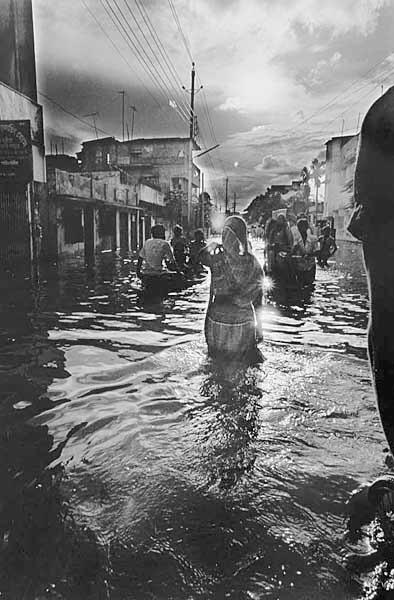
Wading down a street near Kamlapur railway station. “Dreamland Photographers”, the local studio, was still open for business. 2nd September 1988. Dhaka Bangladesh. ? Shahidul Alam/Drik/MajorityWorld
What is relevant is that now the roads are dry and the walls repainted and that a nation that once so cared has so quickly forgotten.
I look back and merely feel the ineffectuality of my images.
Shahidul Alam
Dhaka 1988
Nearly twenty years on, the floods are with us again. They are a part of our natural agricultural cycle. They irrigate the land, replenish the topsoil, remove the toxins. But deforestation in the mountains, illegal constructions, ill planned roads and ill caring leaders make floods take on a violent form. The waters get angry.
This year, when the waters had risen, our adviser advised that it was not yet a calamity. When the waters reached danger levels, the decree came that because of the state of emergency, ‘[political] banners were banned’ so while people struggled for food and shelter, banner rights became the issue. Now as the waters engulf the land and people flounder in need of relief, our adviser advises us ?we don?t have to help the people, they?re going to their relative?s house by themselves?.
Now that is a solution Bangladesh can offer to all the distressed people in the world. Just go find a relative.
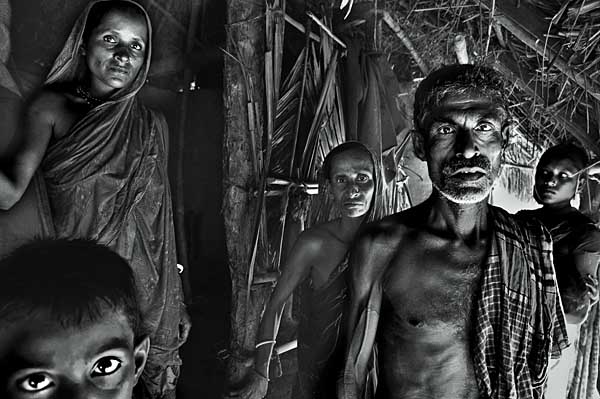
Before the floods. People affected by cyclone Akash. Mohishshoiri River. Khulna. 21 May 2007. ? Tanvir Ahmed/DrikNews
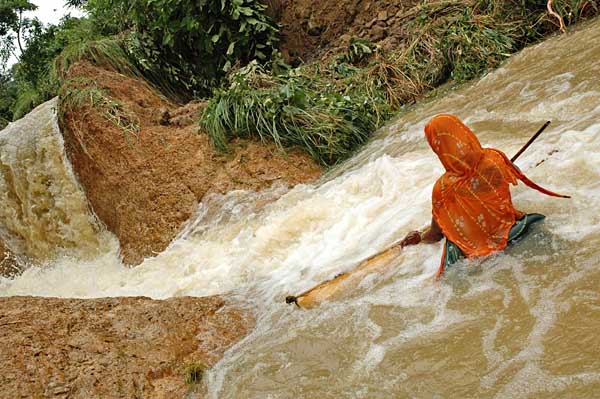
Woman fishes in the flood waters. 13 June 2007. Comilla Bangladesh. Kalim Shantu/DrikNews
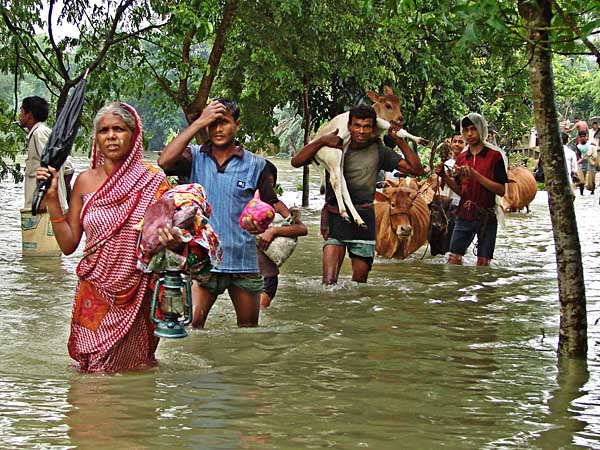
Twenty villages had been affected at the junction of the rivers Ghagot, Brahmaputra and Teesta making numerous people homeless. 31 July 2007. Gaibandha. Bangladesh ? Quddus Alam/DrikNews
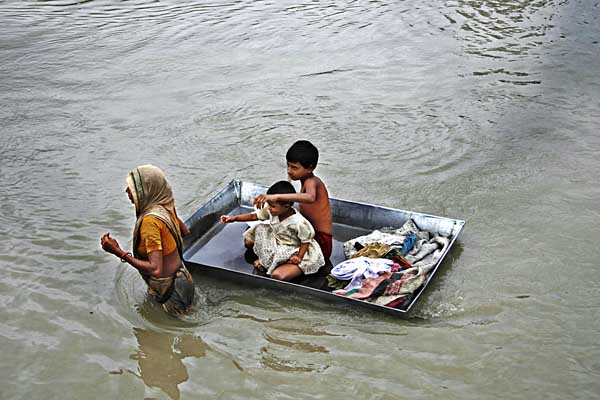
Woman in search of dry land. 30 July 2007. Sirajgonj Bangladesh ? Tanvir Ahmed/DrikNews
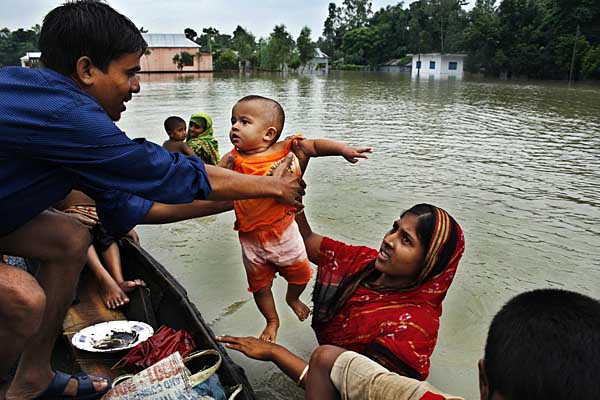
Villagers rescuing mother and child. 30 July 2007. Sirajgonj Bangladesh ? Tanvir Ahmed/DrikNews
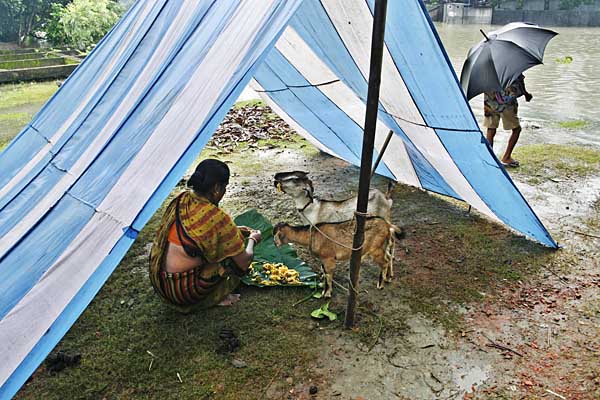
Woman feeding goats in makeshift tent. 30 July 2007. Sirajgonj Bangladesh ? Tanvir Ahmed/DrikNews
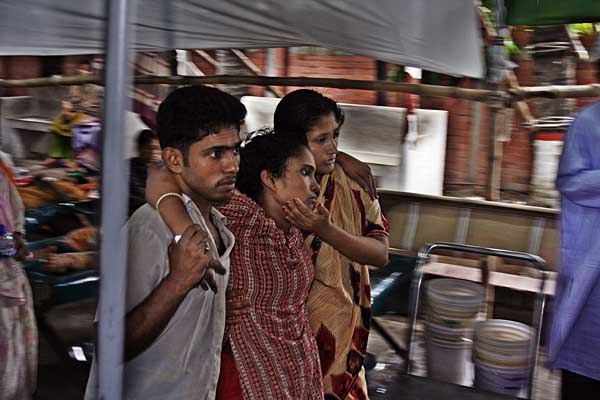
Diarrheal patients at hospital in Dhaka. 11 August 2007. Dhaka Bangladesh ? Munir uz Zaman/DrikNews
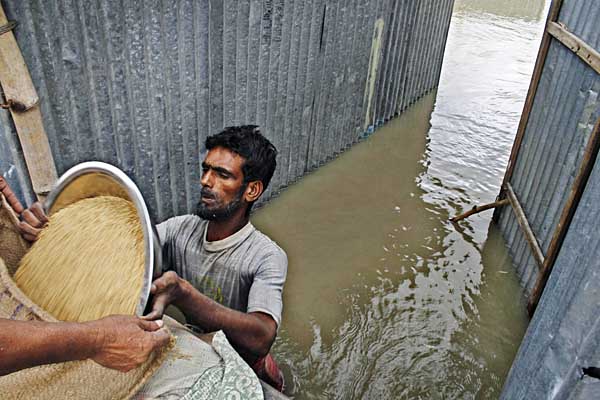
Spontaneous relief operations organised by citizen groups. 30 July 2007. Sirajgonj Bangladesh ? Tanvir Ahmed/DrikNews
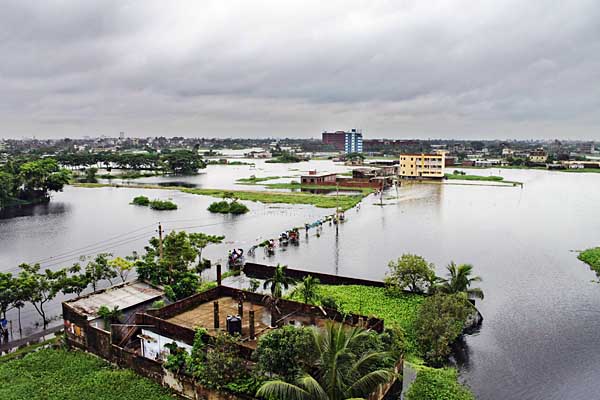
While one third of the country was flooded, people inside the DND (Dhaka Narayanganj Demra) embankment faced the stagnant water cause by rains. 25 July. Narayanganj Bangladesh ? Tanvir Ahmed/DrikNews
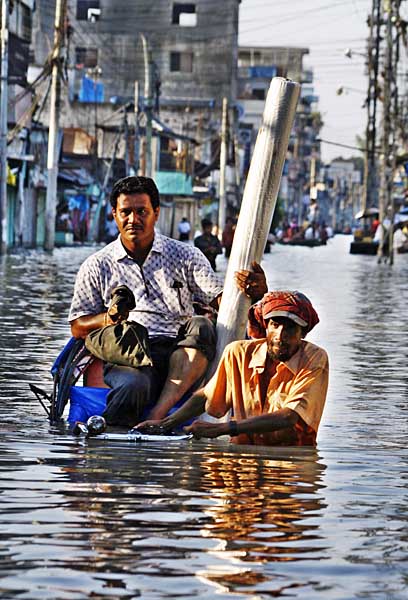
700,000 people were marooned in Sirajgonj. 64 people had already died when this photograph was taken. 5 August 2007. Sirajgonj Bangladesh ? Tanvir Ahmed/DrikNews
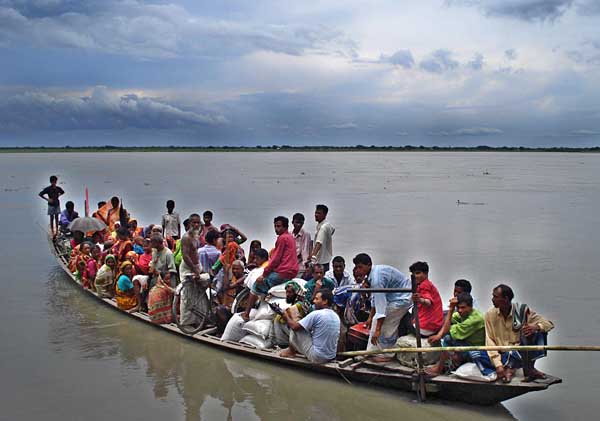
Boats are the only means of communication during floods. July 2 2007. Rangpur, Bangladesh. ? Ador Rahman/DrikNews
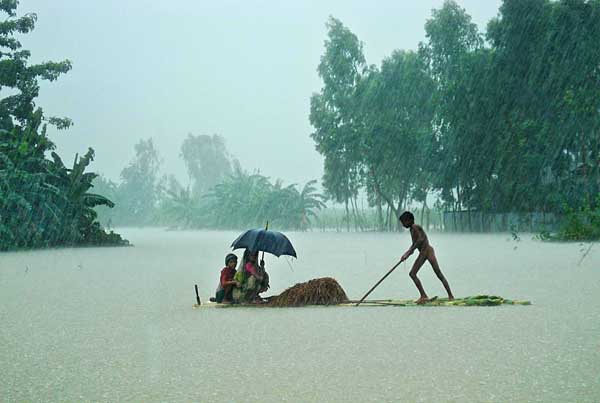
A family looks for shelter using a raft made of banana trees. 31 July 2007. Gaibandha Bangladesh ? Quddus Alam/DrikNews
And across the border, viewed from afar:
The Rains Reach Kolkata
When I was just a little boy, I watched the clouds advance
From rooftop high above the streets and bustle of Calcutta.
Up there, I watched the hawks soar high, and saw the palm fronds’ dance,
In wind that blew before the storm, and banged each window shutter.
It was in June, when summer’s heat had risen to its height,
That clouds approached, as though for war, advancing in a line,
Their heads held high, dark wall beneath — a fear-instilling sight,
With lightning streaks, and thunder-growls of warriors divine.
The sparrows, crows and pigeons fled, in haste to get away
And find refuge, as dust was blown from streets by gusts so strong
That palm trees bent, and tossed their heads, and back and forth did sway,
As leaves and clothes, and sailing fronds, with birds were swept along.
Then from the heat, we knew respite, as cool winds did descend
>From belly of the thunderhead, which bore a mist so fine,
With ions, whose electric charge did minds and bodies mend
And lift from summer somnolence like clear celestial wine.
And I would run and scramble down, from perch on highest roof,
To shelter in a doorway, where I still could watch the storm
Without myself being blown away, or struck by lightning hoof,
As racing clouds obscured the sky, like wraiths in equine form.
And then the dark, the greenish gloom, the flash more bright than sun,
The crack so loud it seemed the earth was cloven by the sky,
And pelting rain in slanting sheets, like bullets from a gun,
On roofs of tin, and wooden shades, and roll of thunder high!
And so the chariots of the gods would roll by overhead,
And we could hear the neighs and roars, and see the sparks that flew
As titans battled in the skies, by trumpet blowers led,
And sword of land pierced mail of sea, and blood of rain then drew.
And all the kids would venture out, unheeding of the scolds,
To jump with glee and leap and splash, in dance as old as time,
And yet as freshly bold that day, as in the eons old,
When sea would come to land to fight, and mate, in yearly rhyme.
Babui / Arjun Janah*
2007 August 11th, Sat.
Berkeley, California
*Arjun has an identity of his own, but for us photographers, he is the son of the legendary Indian photographer Sunil Janah.
Boxing Day Blues
When Jolly’s son Asif asked me to take a portrait of him and his new bride Rifat, I took it on with grandfatherly pride. The photo session was booked for Sunday morning, the 26th December 2004. Boxing day.
The envelope from Sri Lanka also arrived on Boxing Day. 2006. Priantha and his daughter Shanika had sent me Christmas greetings. I felt bad that I had not sent them one.
I used to love the winding path up to the hilltop house in Chittagong. Zaman Bhai was the chief engineer of the Chittagong Port Trust. One of the few Bangalis in high positions in 1971. It is thirty five years since the Pakistanis took him away, but even many years after liberation, my cousin Tuni Bu would still look for him. Anyone going to Pakistan would be given the task of trying to find out if there was any knowledge of where he might have been taken, what might have happened. One knows of course what must have happened, and I am sure Tuni Bu knows too, but that never stopped her from trying to find out. She was much older than me, and it was my nephews Bulbul and Tutul and my niece Jolly, that I was close to. Atiq was too young in those days to qualify for our friendship. The house had a fountain and the surrounding pool was our swimming pool. It was the only home I had ever known that had a pool. Technically I was of granddaddy status to Jolly’s son, and the young man reminded me of my own happy childhood.
While I played around with the studio lights, Asif told me of the Richter 9 earthquake that had hit Bangladesh. Of course I didn’t believe him. Richter 9 is big and there simply couldn’t have been an earthquake of such magnitude without anyone registering it. But I did turn on the news immediately after the portrait session, and the enormity of the disaster slowly sank in. I rang Rahnuma and asked her to turn on the television, and went back to work. By then however, the news of the carnage in places thousands of miles away started coming across the airwaves.
The next day the numbers steadily rose from the hundreds to thousands and we were glued to the set. Though we hadn’t said it out aloud to each other, both Rahnuma and I knew I had to go. BRAC had organized a training for women journalists in their centre in Rajendrapur on the 28th. I had committed myself to the training some time ago and couldn’t really bail out in the last minute. On the way I heard from Arri that my friend in Colombo Chulie de Silva was missing. I kept losing the signal on my Grameen mobile phone on my way to and from Rajendrapur, but near Dhaka I managed to get text messages through. Chuli was safe, but her brother had died.
Babu Bhai managed to get me a flight the next day via Bangkok. I had posted an angry message in ShahidulNews in response to the tourist centric reporting in mainstream media and many friends responded. Margot Klingsporn from Focus in Hamburg wired me some money. Not waiting for the money to arrive, I gathered the foreign currency I could lay my hands on, packed a digital camera and a video camera along with my trusted Nikon F5 and left. That was when I made friends with Shanika.
http://www.zonezero.com/tsunami/shahidul/article.html
It was Chulie who helped trace her. She had heard my story and wrote to me that she had found a “Shanika Cafe” near Hikkaduwa. We had gone out together in search of the girl. When we did find Shanika and her dad Priantha, she rushed to my arms.

Through Chulie’s translations Priantha told me that Shanika had been withdrawn and wouldn’t relate to people. It was our friendship that had brought out the little girl.
More than the wreckage and the rotting flesh,
I remember the mother in the refugee camp stealing a kiss from her new born child.
I remember the family sitting in the wreckage of their home in Hikkaduwa, going through the family album.
I remember the devotees returning to the Shrine of Our Lady of Matara Church to pray.
As a photojournalist we are touched by, and touch many people’s lives. Sometimes – not often – we are able to make a difference. But invariably we move on. On to another disaster, another success, another story in the making. The Shanikas of our stories, become yet more stepping stones in our career path, and the Christmas cards flow only in one direction.
Shahidul Alam
28th December 2006
I hear the screams
![]()
Even after years of playing Pied Piper with a camera, I am still taken aback by children insisting on being photographed. It was September 1988, and we had had the worst floods in a century. These people at Gaforgaon hadn’t eaten for three days. A torn saree strung across the beams of an abandoned warehouse created the only semblance of a shelter. Their homes had been washed away. Family members had died. Yet the children had surrounded me. They wanted a picture.
It was dark in that damp deserted warehouse, but the broken walls let in wonderful monsoon light, and they jostled for position near the opening. It was as I was pressing the shutter that I realised that the boy in the middle was blind. He had pushed himself into the centre, and though he wasn’t tall he stood straight with a beaming smile.
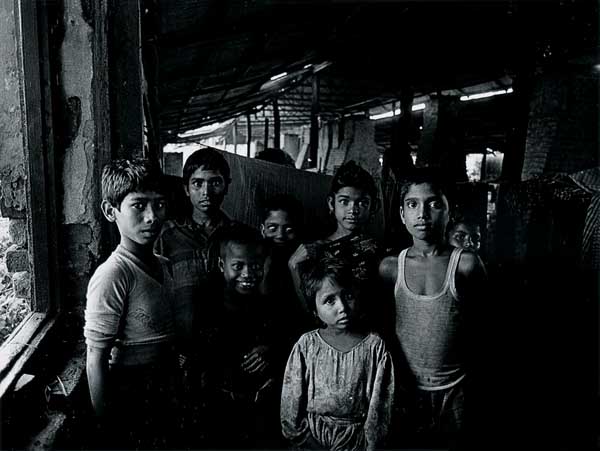
Shahidul Alam/Drik/CARE
Clip on story of the blind child, from keynote presentation on citizen journalism at 50th Anniversary of World Press Photo in Amsterdam.
I’ve never seen the boy again, and today I question the fact that I do not know his name. But he has never left my thoughts and often I have wondered why it was so important for that blind boy to be photographed.
It’s happened elsewhere, in boat crossings at the river bank. In paddy fields heavy with grain, in busy market places. A shangbadik (literally a journalist, but in practice any person with a half decent camera) was hugely in demand. They refused to take the fare from me at the ferry ghat. Opened up their hearts and told me their most personal stories. Confided their secrets, shared their hopes. Never having deserved such treatment it has taken a while for me the photographer, to work out why being photographed meant so much to that blind child.
The stakeholders of Bangladeshi newspapers are the urban elite. Consequently stories from the village are about the exotic and the grotesque. Village people exist only as numbers, generally when plagued by some disaster and only when figures are substantial. A photograph in a newspaper, regardless of how token the gesture, is the only time a villager exists as a person. A picture on a printed page would have lifted that blind boy from his anonymity. That humbling thought stays with me whenever I am feted as a shangbadik in some small village. I receive their gift of trust gently, careful not to break the delicate contents.
It was as a photographer of children that I had begun my career. It was way before 9/11 and one could make appointments with strangers and go to their homes. I took happy pictures of kids, and parents loved them. It was easy money, except when I would photograph the children of poor parents. They loved the pictures but couldn’t afford to pay, so I would quietly leave the pictures behind and pay the studio out of my pocket. Back in Bangladesh, the only way I could make money was as a corporate photographer, but something else was happening. We were in the streets, trying to bring down a general who had usurped power. I didn’t know it then, but I was becoming a documentary photographer. Suddenly taking pictures of children meant more than smiling kids on sheepskin rugs.
As the pressure against the general mounted, I photographed children who joined the processions. The night he stepped down, I photographed a little girl with a bouquet of flowers. She was out with her dad in the middle of the night, celebrating the advent of democracy.
I am back in Kashmir eight months after I had been here photographing the advent of winter. The valleys of this fertile land are green with new crops, 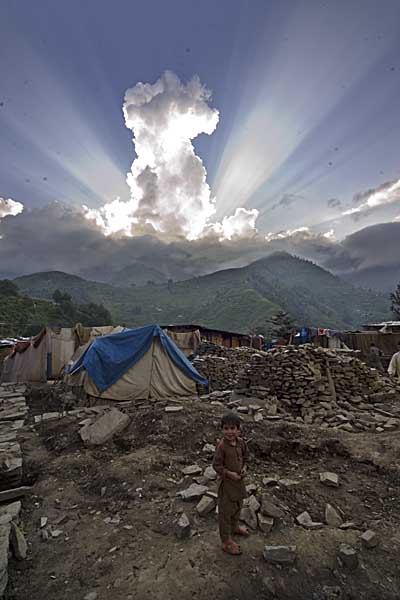
Shahidul Alam/Drik/CONCERN
but many of the homes are still to be rebuilt. As I walked through the rubble, the kids again wanted to be photographed.
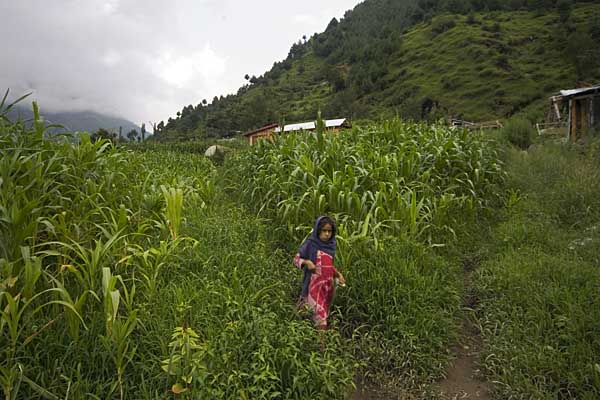
Shahidul Alam/Drik/CONCERN
Najma came running, her bright red dress popping out of the green maize fields.Unsure at first, she smiled when I told her she had the same name as my sister.
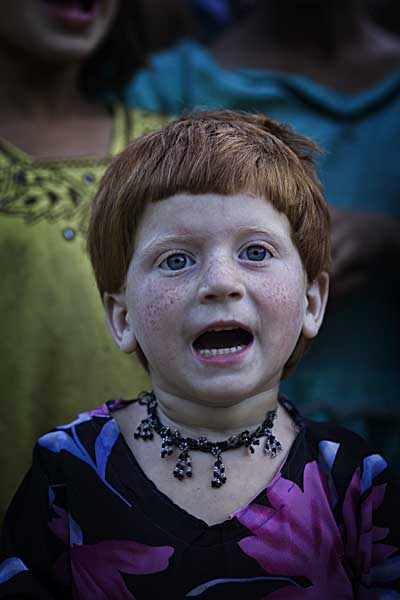
Shahidul Alam/Drik/CONCERN
Zaheera, a cute girl with freckles, gathered her friends and sang me nursery songs. But my thoughts are far away. Despite the laughter and the nursery songs very different sounds enter my consciousness. I remember the children screaming on the night of the 25th March 1971, when I watched in helpless anger as the Pakistani soldiers shot the children trying to escape their flame throwers. The US had sent their seventh fleet to the Bay of Bengal, in support of the genocide. Today, as I remember the Palestinians and the Lebanese that the world is knowingly ignoring, I can hear the bombs raining down on Halba, El Hermel, Tripoli, Baalbeck, Batroun, Jbeil, Jounieh, Zahelh, Beirut, Rachaiya, Saida, Hasbaiya, Nabatiyeh, Marjaayoun,Tyr, Jbeil, Bint Chiyah, Ghaziyeh and Ansar and I hear the screams of the children. Piercing, wailing, angry, helpless, frightened screams.
News filters through of the children killed in the latest bombing. The photographs have kept coming in, horrific, sad, and disturbing. Mutilated bodies, dismembered children, people charred to ashes. But none as vulgar as those of Israeli children signing the rockets. Death warrants for children they’ve never known.
I remember my blind boy in Gaforgaon. The Lebanese and the Palestenians are also people without names. Their pain does not count. Their misery irrelevant, their anger ignored. Sitting in far away lands, immersed in rhetoric of their choosing, conjuring phantom fears necessary to keep them in power, hypocritical superpowers fail to acknowledge the evil of occupation. The ‘measured response’ to a people’s struggle for freedom will never in their reckoning allow a Lebanese or a Palestinian to be a person.
When greed becomes the only determining factor in world politics. When the demand for power, and oil and land overshadows the need for other people’s survival, I wonder if those screams can be heard. I wonder if those Israeli children will grow up remembering their siblings they condemned. I wonder if through all those screams the war mongers will still be asking “why do they hate us”?
11th August
Siran Valley, North West Frontier Province, Pakistan

